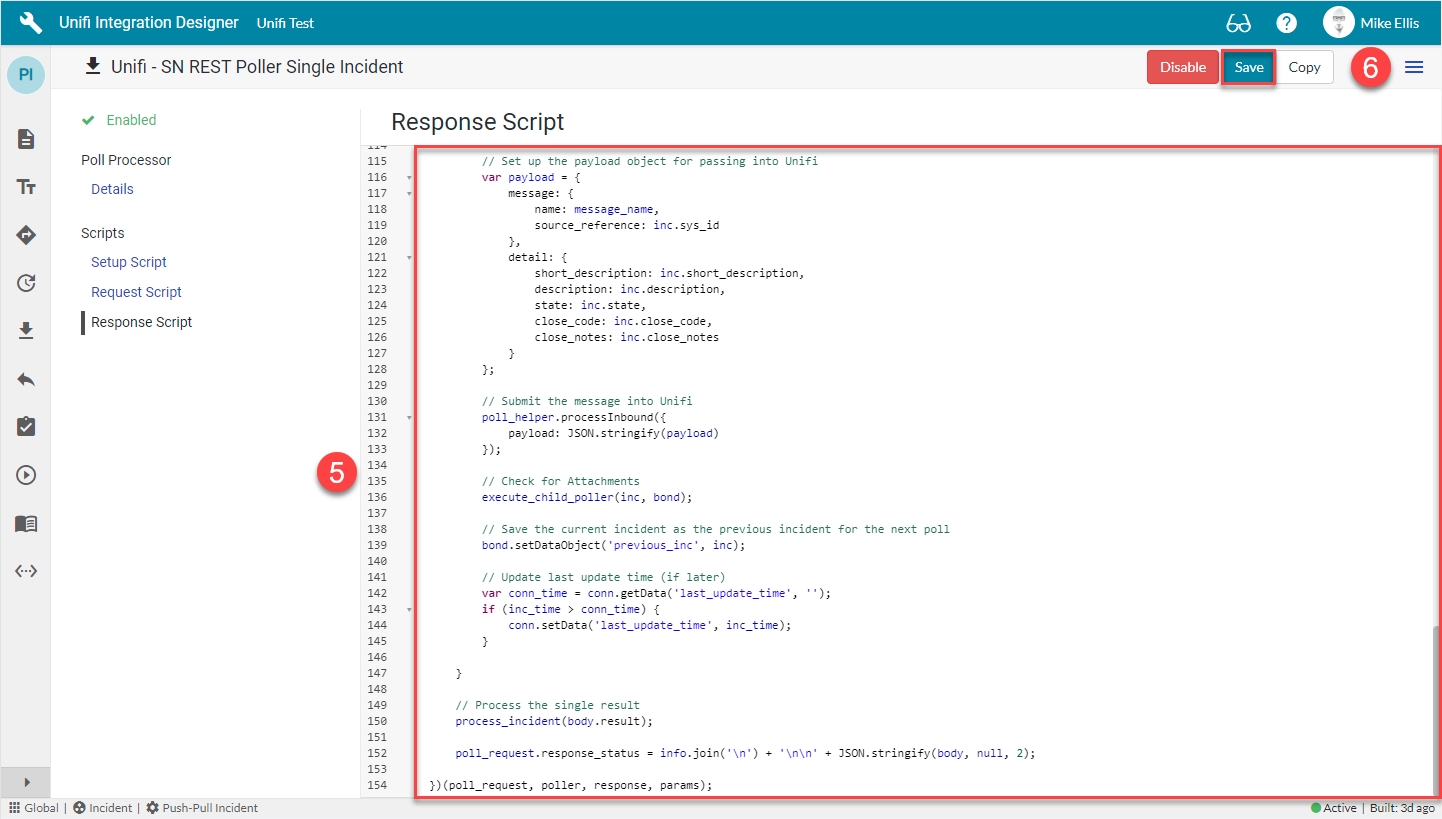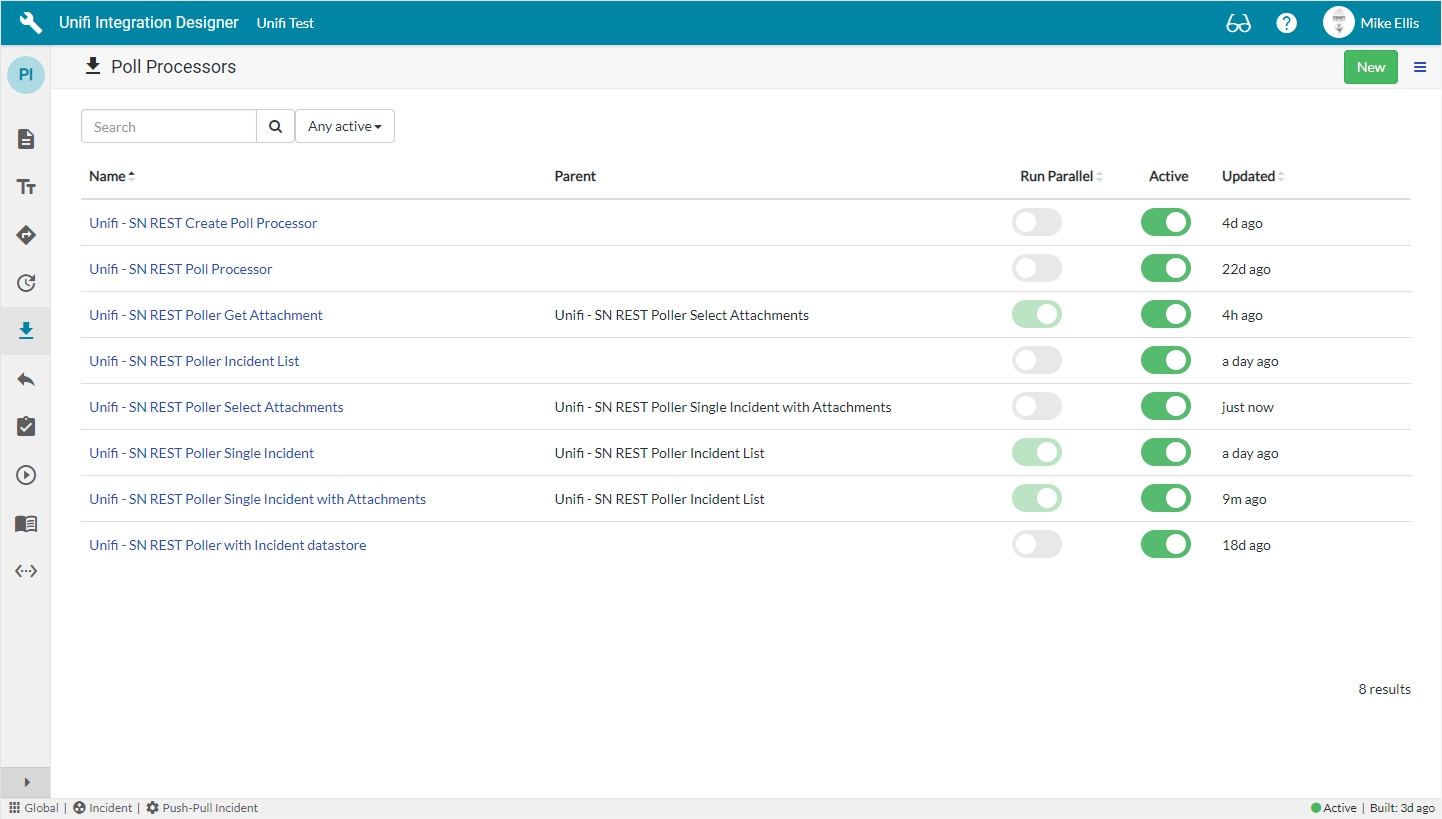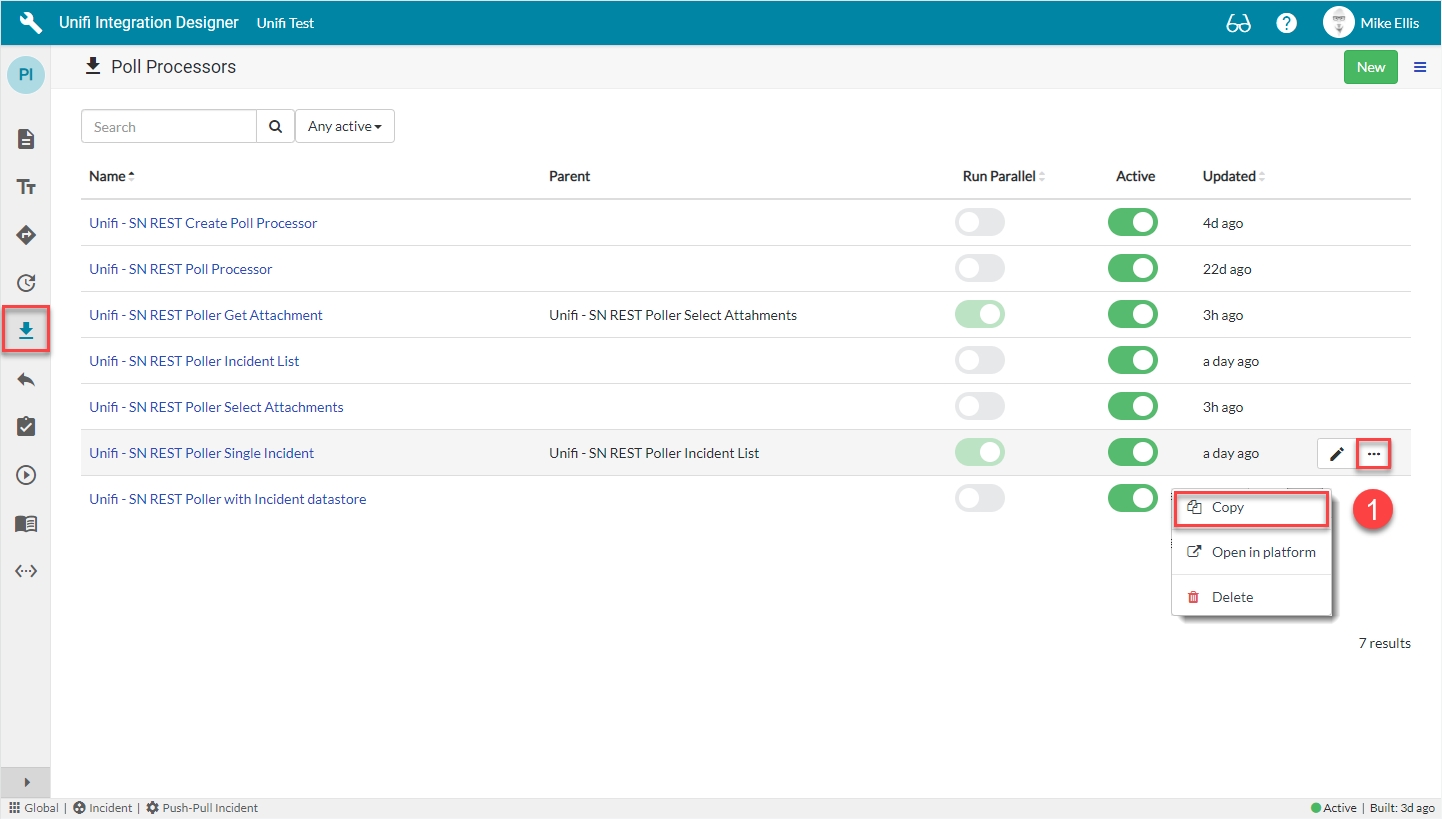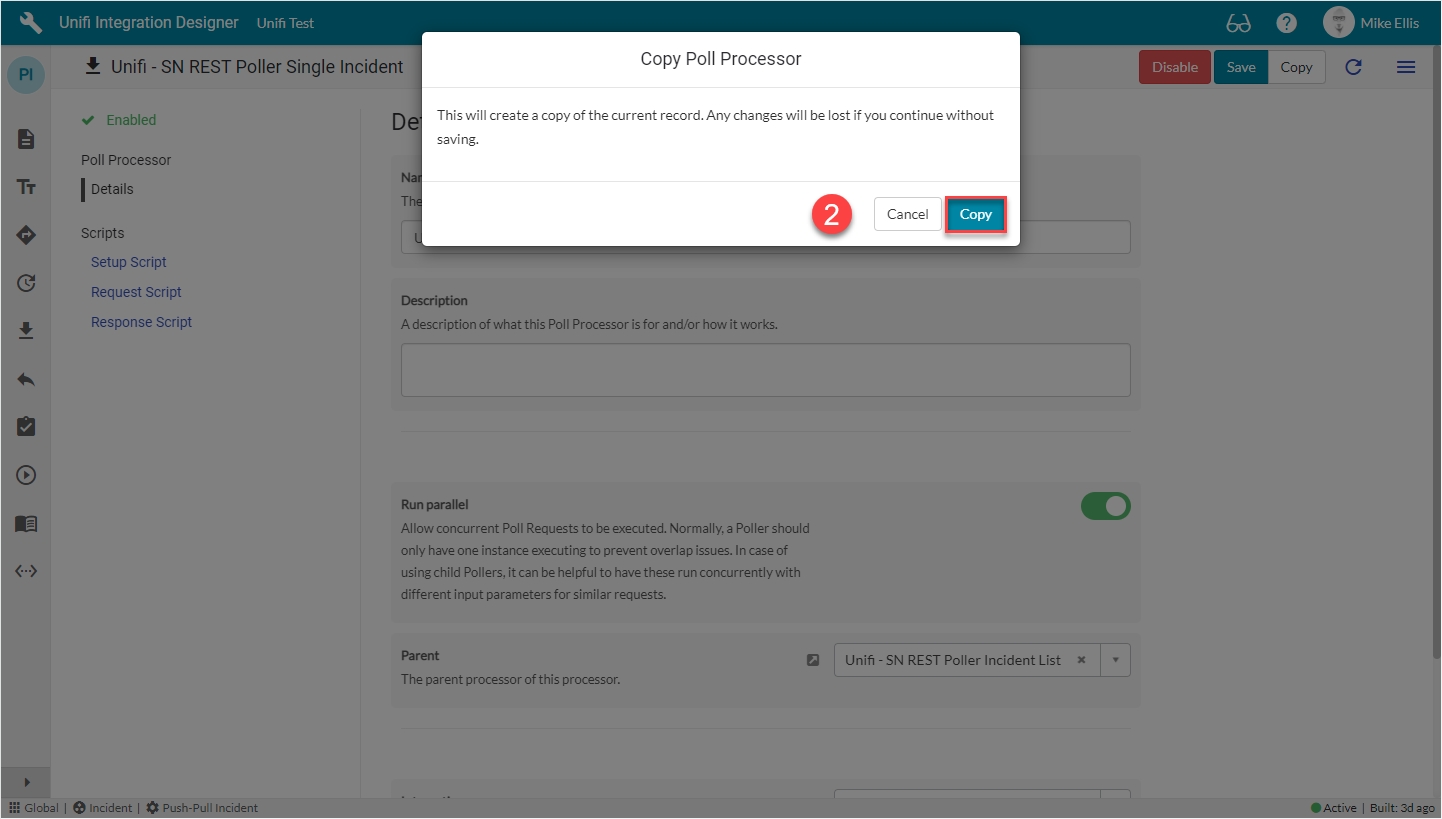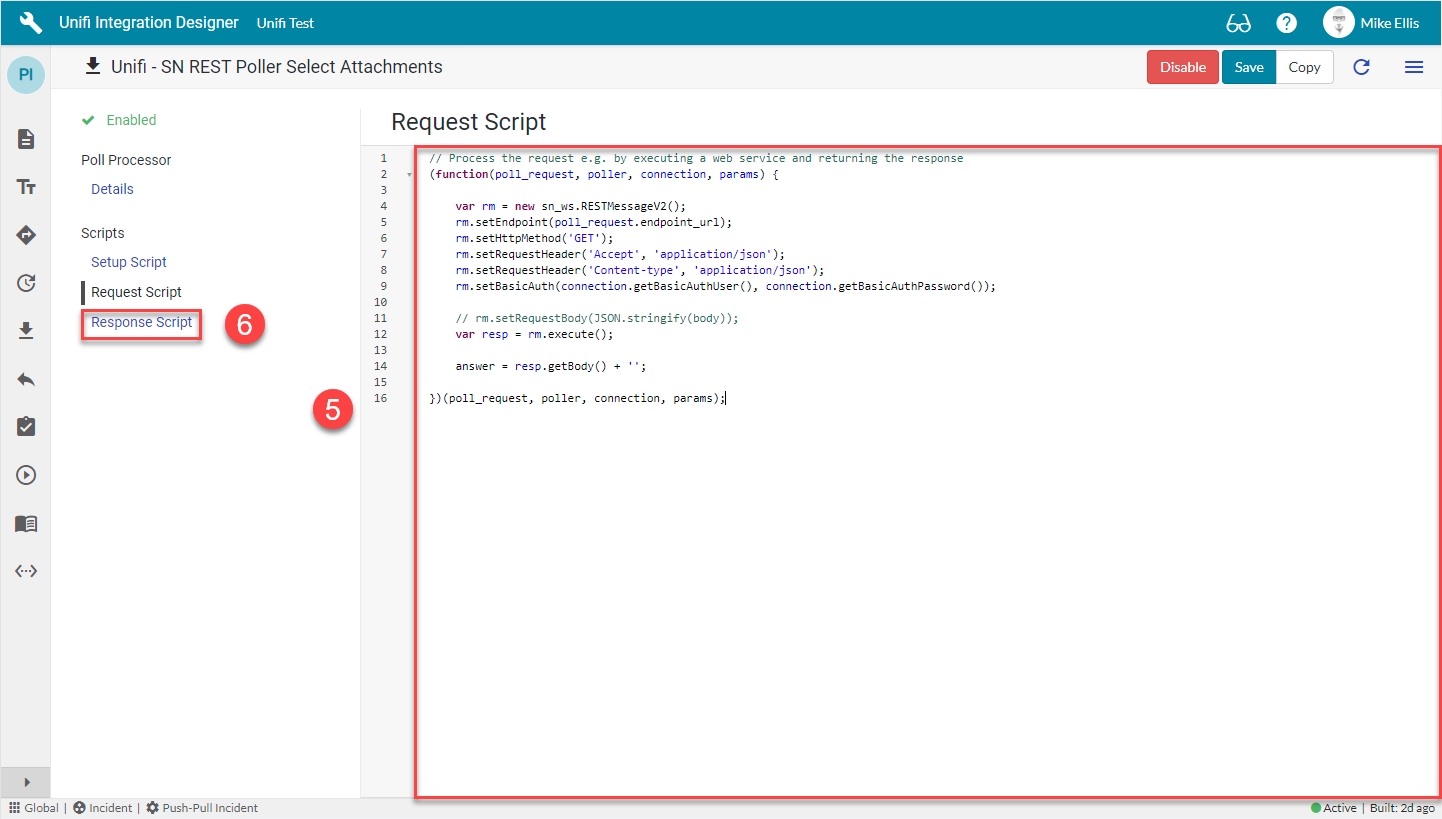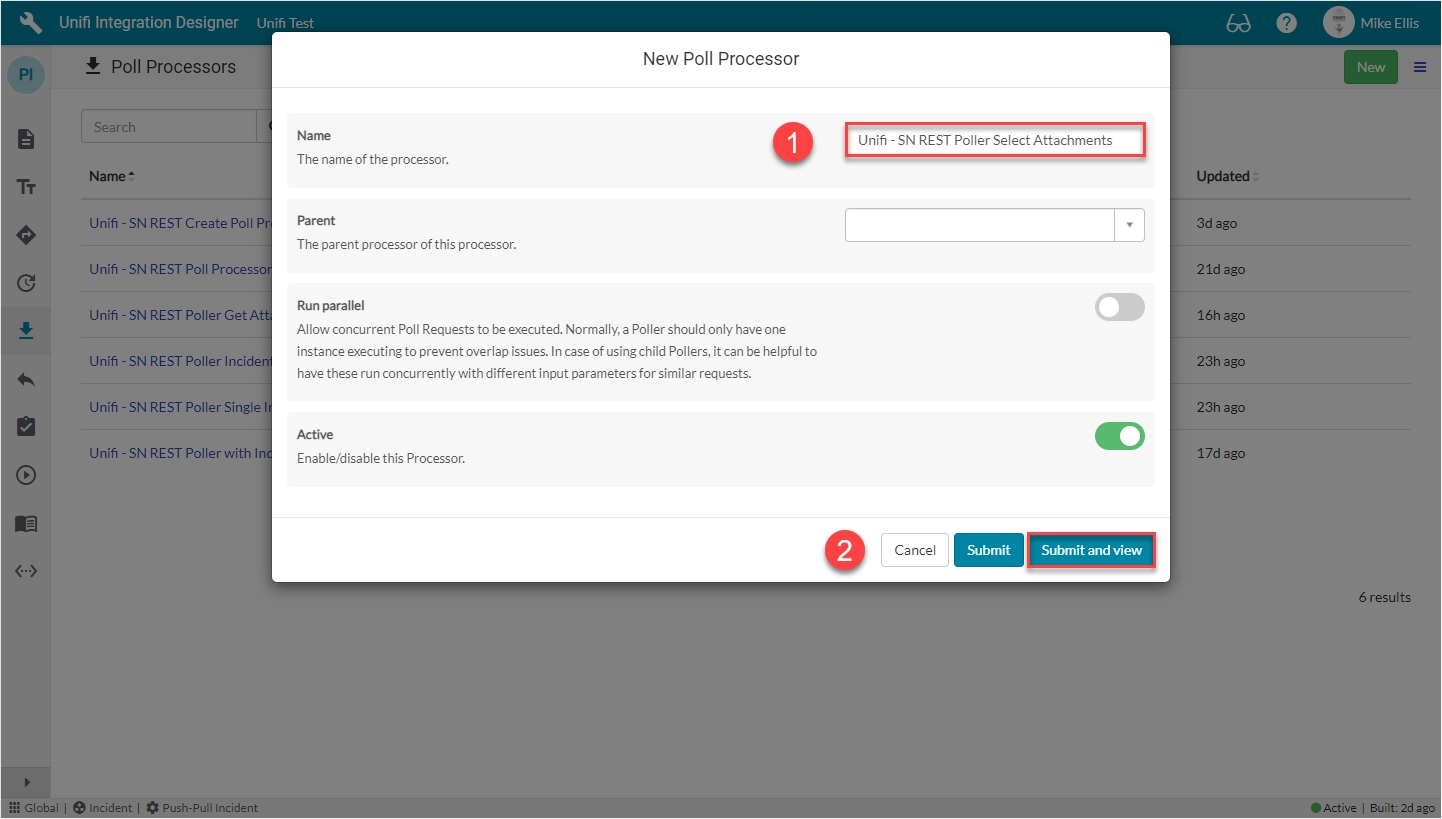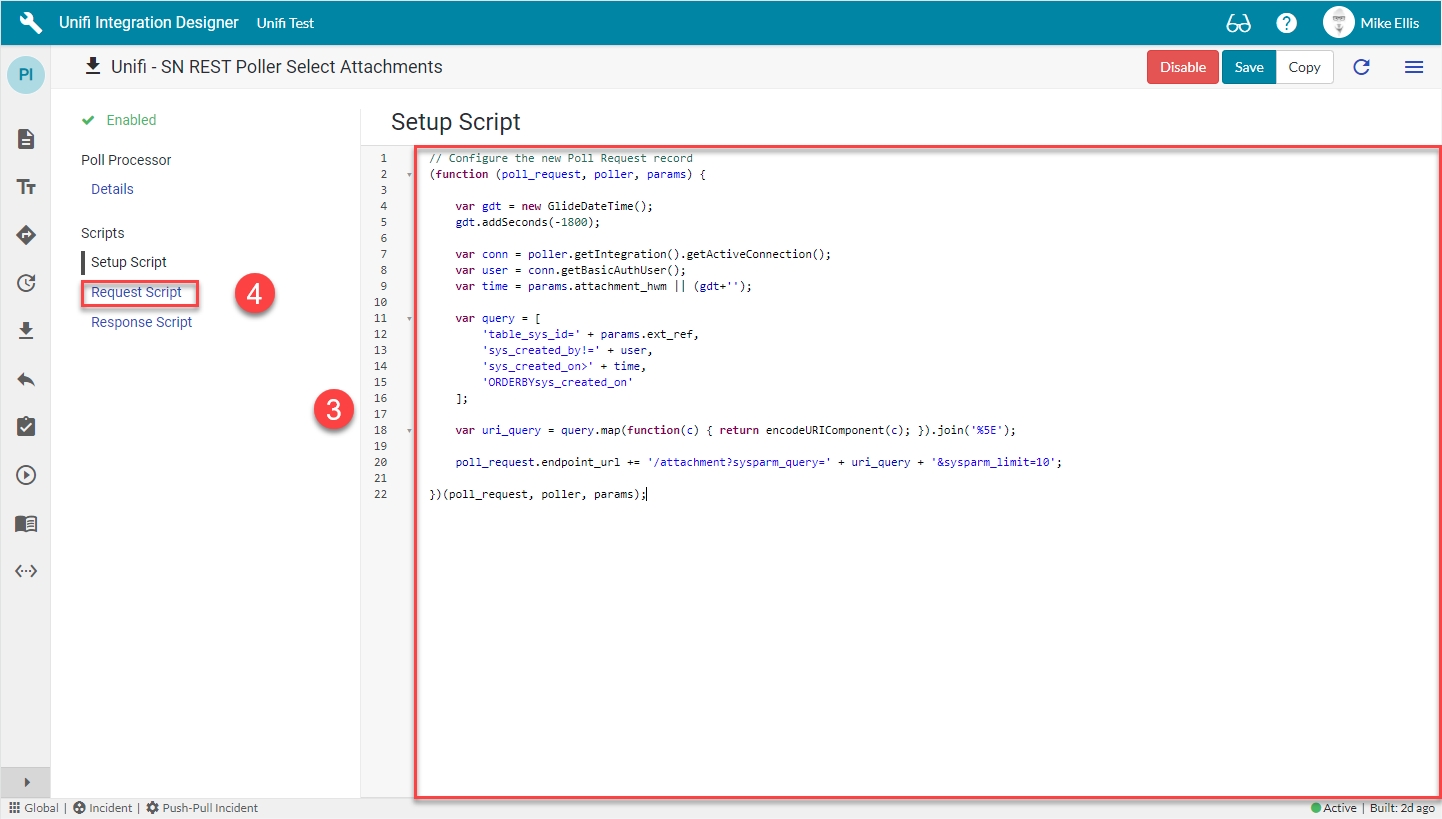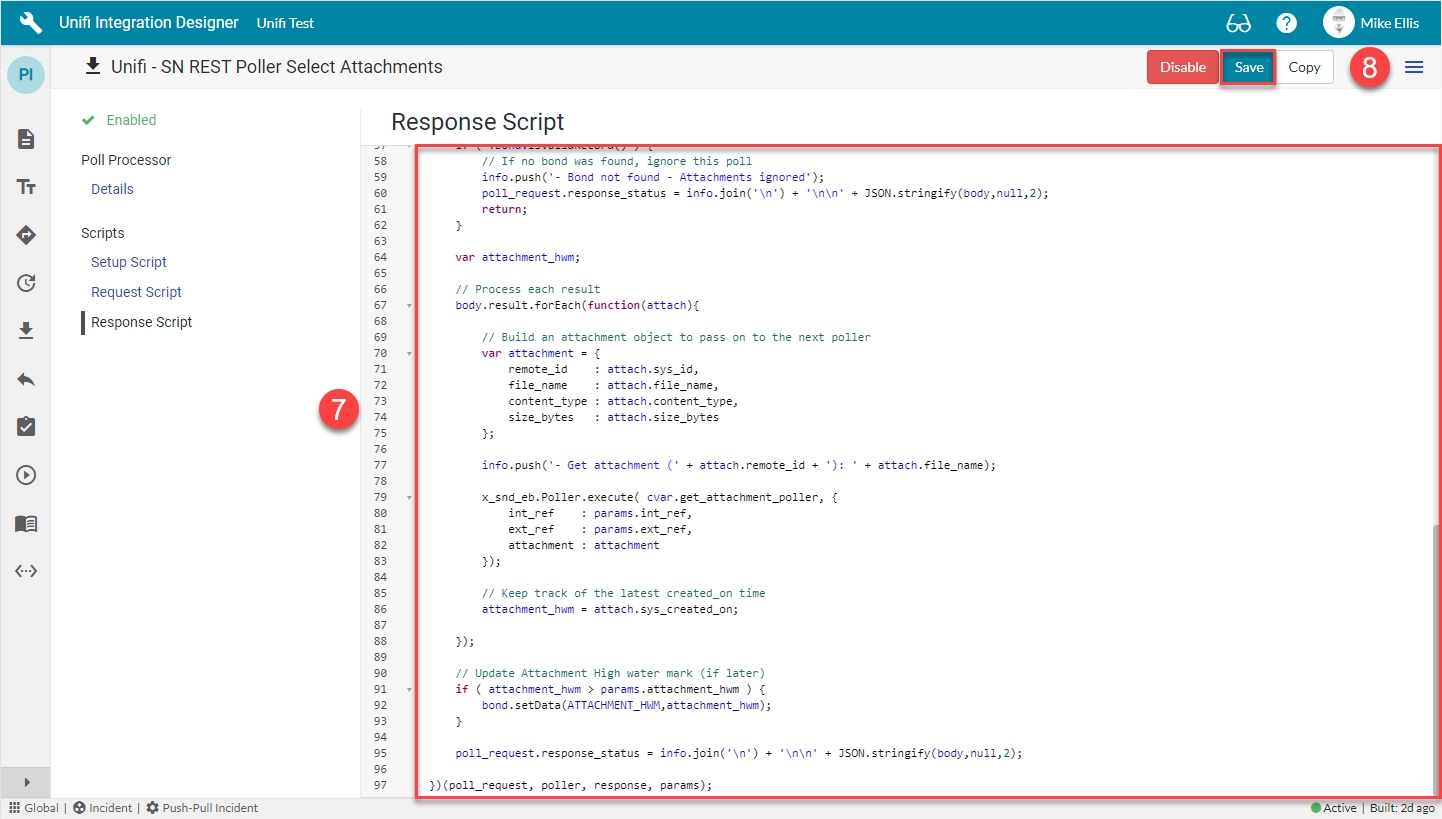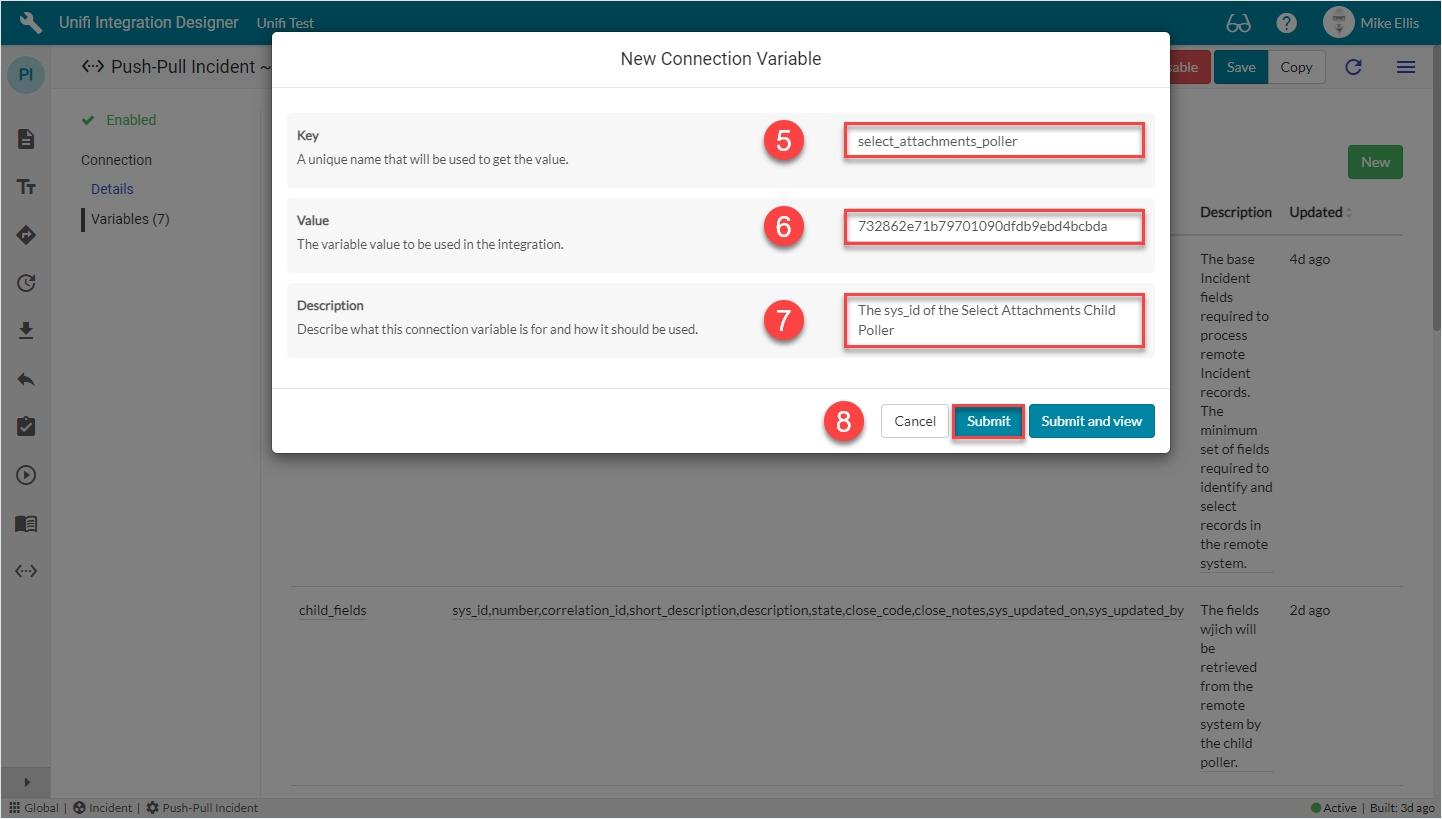
Loading...
Loading...
Loading...
Loading...
Loading...
Loading...
Loading...
Loading...
Loading...
We will configure an on-demand poll to query the remote system and pull back a list of attachments added to bonded records that have changed. Each will then be retrieved by another on-demand poll.
To set up an on-demand poll that will query the remote system for attachments and pass each to a subsequent poll, which will then retrieve them and pass them to Unifi to process, we will need to configure a further two each of the following records:
Child Poll Processor
Child Poller
(Note: one of the children will be a parent to the other)
We will also need to edit the previously configured (per the Parent & Child Poller Guide) to kick-off the first of our attachment Child Pollers.
To facilitate polling both the Table API and Attachment API, we may also need to make changes to the Endpoint URLs* configured in earlier Guides in the following places: (*only if the Connection contains the full endpoint url)
Connection
Outbound Message Path
Poll Processor Setup Script
We will look at each of those edits and the polling records in turn over subsequent pages. Before configuring those records, let’s first look at Connection Variables.
Connection Variables can be especially useful if you have multiple connection environments - e.g. Dev, Test, Prod - each containing different data.
Instead of scripting data values directly into the code of your Poll Processor scripts, it may be better practice to use Connection Variables in their place. Not only does it make those scripts cleaner, but it also means that changes in requirements can be more easily enacted by changing the values of the data in those variables, without having to change the code in the scripts.
We will create an additional two Connection Variables to identify the Child Pollers we shall be creating.
The icons are:
a) 'Integration' icon: Opens the current integration's Details page.
b) 'Pollers' icon: Opens the current integration's Pollers page.
c) 'Poll Processors' icon: Opens the current integration's Poll Processors page.
d) 'Connections' icon: Opens the current integration's Connections page.
This variable will contain the sys_id of the child Poller which we will create on the '' page of this Guide. Once you have created the Poller, copy the sys_id and paste it as the value in this variable.
To open Unifi Integration Designer, navigate to Unifi > Unifi Integration Designer, then navigate to < Your Integration > (created following the Outbound Incident Guide).
Click the 'Connections' icon, then navigate to and open < Your Connection >.
From the Connection, navigate to Connection > Variables & click New.
The 'get_attachment_poller' New Connection Variable fields to be configured are as follows:
Your 'get_attachment_poller' New Connection Variable modal should look like this:
Click Submit.
You will be redirected back to the Variables page of the Connection record.
This variable will contain the sys_id of the child Poller which we will create on the '' page of this Guide. Once you have created the Poller, copy the sys_id and paste it as the value in this variable.
From the Connection, navigate to Connection > Variables & click New.
The 'select_attachments_poller' New Connection Variable fields to be configured are as follows:
Your 'select_attachments_poller' New Connection Variable modal should look like this:
Click Submit.
The following Connection Variables should now be in place for your Connection:
Now let's move on and edit the Endpoint URLs.
We have previously been polling the Table API of our PDI. We now want to poll the Attachment API. To facilitate this, we will need to make changes to the Endpoint URLs in multiple places.
The instructions on this page only apply if you have configured the Connection with the full endpoint url (including the /table/incident element).
If you have used the truncated url in the Connection (moving the /table/incident element to the outbound Message path & Poll Processors), this page may be skipped.
To facilitate polling both the Table API and Attachment API, we will need to edit the Endpoint URLs configured in earlier Guides in the following places:
Connection
Outbound Message Path
Previously Configured Poll Processors
First, edit the Endpoint URL in the Connection.
In Unifi Integration Designer, navigate to the 'Connections' icon. Click to open & edit < Your Connection > (configured following the Outbound Incident Guide).
Remove /table/incident from the Endpoint URL and Save. (This will be prepended to the Outbound Message Path & previously configured Poll Processors.)
Edit each of the previously configured Outbound Messages:
CreateIncident
UpdateIncident
ResolvIncident
CreateIncidentInboundReceipt
To edit the CreateIncident Message, navigate to the 'Messages' icon & click to open the CreateIncident Message.
Navigate to Outbound > Settings. Add the previously cut /table/incident to the Path & Save.
Repeat for each of the other Outbound Messages.
DO NOT delete the existing path, rather prepend it with /table/incident (as cut from the Connection). For example, the Path for the UpdateIncident Message should now read as follows: /table/incident/{bond.getValue("external_reference")}.
Edit the Endpoint URL in the Setup script for each of the previously configured Poll Processors_:*_
Unifi - SN REST Poll Processor (as configured in the
Unifi - SN REST Poller with Incident DataStore (as configured in the )
Unifi - SN REST Create Poll processor (as configured in the )
To edit the Unifi - SN REST Poll Processor, navigate to the 'Poll Processors' icon & click to open the Unifi - SN REST Poll Processor.
Navigate to Scripts > Setup Script.
Edit the code by prepending the existing Endpoint URL with /table/incident i.e. insert it immediately after the poll_request.endpoint_url += ' value & click Save. That line of code should now read as follows:
Your Unifi - SN REST Poll Processor Setup Script should now look like this:
Repeat for each of the other previously configured Poll Processors.
Once complete we can configure the first of our Child Poll Processors, the Get Attachment Poll Processor.
A Poller is a configuration record which defines the frequency of polling and which logic to use.
We will edit the previously created Child Update Poller, so that it runs our new "Unifi - SN REST Poller Single Incident with Attachments" (as created in the previous section) instead of the originally configured Poll Processor.
To edit the Child update Poller, click the 'Pollers' icon.
Click to open < Your Child Update Poller > (created following the )
Unifi - SN REST Poller Single incident (as configured in the 'Child Poll Processor' page of the Incident Parent and Child Poller Guide)
Unifi - SN REST Poller Incident List (as configured in the 'Parent Poll Processor' page of the Incident Parent and Child Poller Guide)
The fields to be edited for the Details form are as follows:
Poll processor
The Poll Processor to use when running this Poller.
<Your Poll Processor>*
Description
A description of what this Poller is for and/or how it works.
<Your Description> (edit accordingly)
*Poll Processor: Value may vary. Choose the Poll Processor you created in the previous section.
Your Details form should look like this:
Save the Poller.
In the next section, we will look at the Inbound Messages.
Key
A unique name that will be used to get the value.
'get_attachment_poller'
Value
The variable value to be used in the integration.
<Your Value>*
Description
Describe what this connection variable is for and how it should be used.
<Your Description>
Key
A unique name that will be used to get the value.
'select_attachments_poller'
Value
The variable value to be used in the integration.
<Your Value>*
Description
Describe what this connection variable is for and how it should be used.
<Your Description>
A Poller is a configuration record which defines the frequency of polling and which logic to use.
A Poller is a configuration record which defines the frequency of polling and which logic to use (the logic itself is defined in the Poll Processor). Each time it is run, it creates a corresponding Poll Request record.
Click the 'Pollers' icon & then New.
The fields to be configured for our Poller record are as follows:
*These fields are mandatory, or automatically defaulted to true.
Your New Poller modal should look like this:
Submit and view to further configure the Poller.
The fields to be configured for the Details form are as follows:
Your Details form should look like this:
Save the Poller.
Update the value of the 'select_attachments' Connection Variable with the sys_id of the child Poller.
Click on the Hamburger Menu and select Open in platform.
The Poller opens in a new window.
Right-click the Header & 'Copy sys_id'.
Open the variable created on the '' page of this Guide and update the value with the copied sys_id.
Next, we will edit our previously configured Child Poll Processor so that it becomes the parent of this.
A Poller is a configuration record which defines the frequency of polling and which logic to use.
A Poller is a configuration record which defines the frequency of polling and which logic to use (the logic itself is defined in the Poll Processor). Each time it is run, it creates a corresponding Poll Request record.
Click the 'Pollers' icon & then New.
The fields to be configured for our Poller record are as follows:
poll_request.endpoint_url += '/table/incident?sysparm_query=' + uri_query +
'&sysparm_fields=' + encodeURIComponent(fields) + '&sysparm_limit=10';Name*
The name of your Poller.
<Your Name>
Poll processor*
The Poll Processor to use when running this Poller.
<Your Poll Processor>
Run
The frequency at which the Poller should run.
'On Demand'
Run as
Poller will run with credentials of specified user.
<Your Inbound user> (from Connection)
Active*
Set to true to use this Poller record for processing.
*These fields are mandatory, or automatically defaulted to true.
Your New Poller modal should look like this:
Submit and view to further configure the Poller.
The fields to be configured for the Details form are as follows:
Description
A description of what this Poller is for and/or how it works.
<Your description>
Your Details form should look like this:
Save the Poller.
Update the value of the 'get_attachment_poller' Connection Variable with the sys_id.
Click on the Hamburger Menu and select Open in platform.
The Poller opens in a new window.
Right-click the Header & 'Copy sys_id'.
Open the variable created on the 'Connection Variables' page of this Guide and update the value with the copied sys_id.
Next, we will configure the Select Attachments Poll Processor.
Name*
The name of your Poller.
<Your Name>
Poll processor*
The Poll Processor to use when running this Poller.
<Your Poll Processor>
Run
The frequency at which the Poller should run.
'On Demand'
Run as
Poller will run with credentials of specified user.
<Your Inbound user> (from Connection)
Active*
Set to true to use this Poller record for processing.
Description
A description of what this Poller is for and/or how it works.
<Your description>
<true>
<true>
Our previously configured Child Poll Processor only polled for updates against records passed to it from its Parent. We will now edit it so that it will also kick off the Select Attachments Poller.
To copy the Child Poll processor, in Unifi Integration Designer, click the 'Poll Processors' Icon.
Click the ellipsis to the right of < Your Child Poll Processor > (created following the ) & then click Copy.
Click Copy.
Your Copy Poll Processor modal should look like this:
You will be redirected to the Details page of the newly copied Poll Processor.
The fields to edit for the Copied Poll Processor are as follows:
Your Copied Poll Processor should look like this:
Navigate to Scripts > Response Script.
The Response Script field is to be edited as follows:
The code in the Response script field should look like this:
Your Response Script form should look like this:
Click Save.
Navigate to and open the Select Attachments Poll Processor (created on the ' page) and update the value of the Parent field by selecting its parent Poll Processor created above.
The following Poll Processors should now be in place on the Integration:
Now let's move on and edit the Child Update Poller (configured when following the Incident Parent and Child Poller Guide) so that it runs the Poll Processor created above.

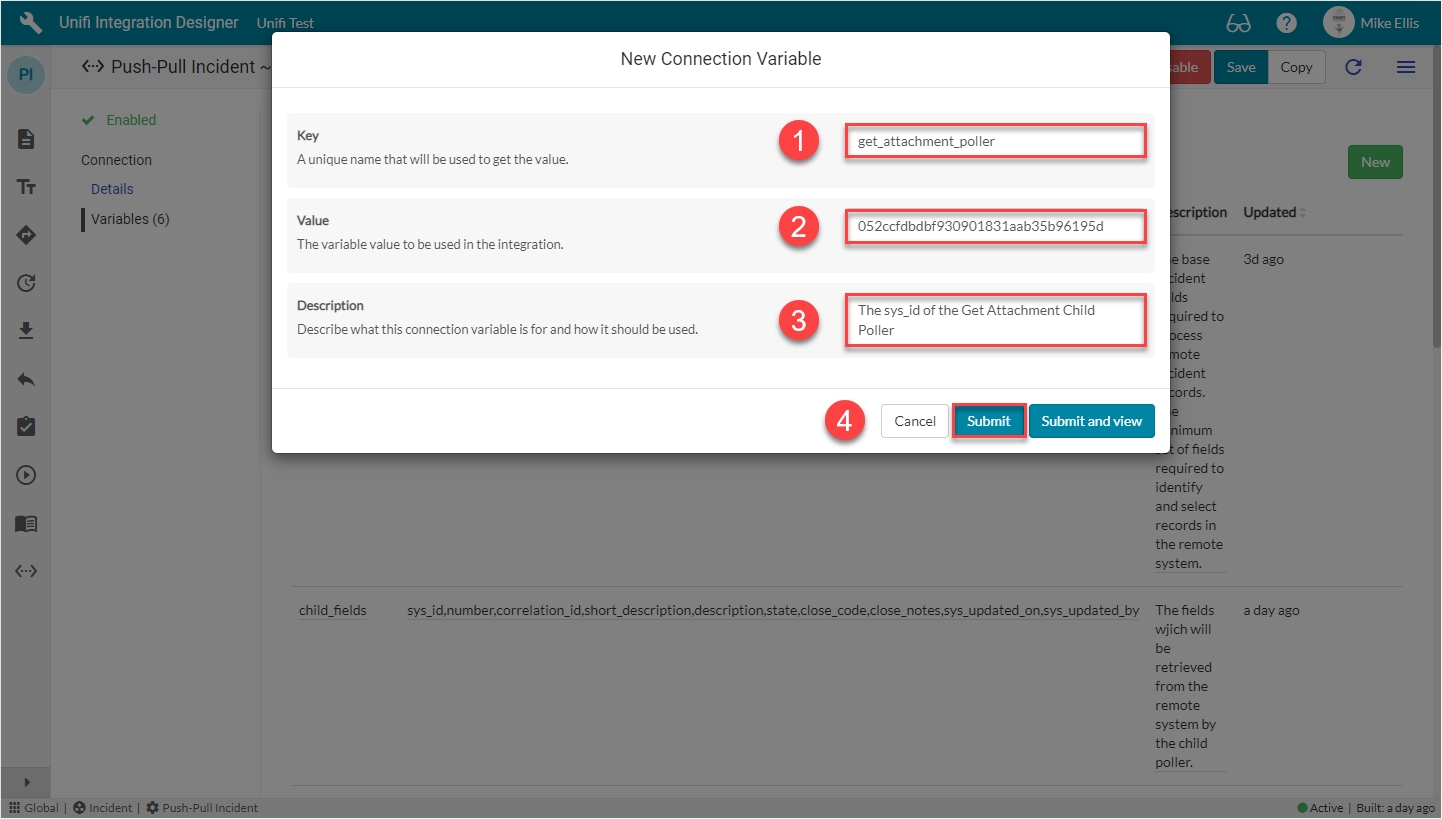
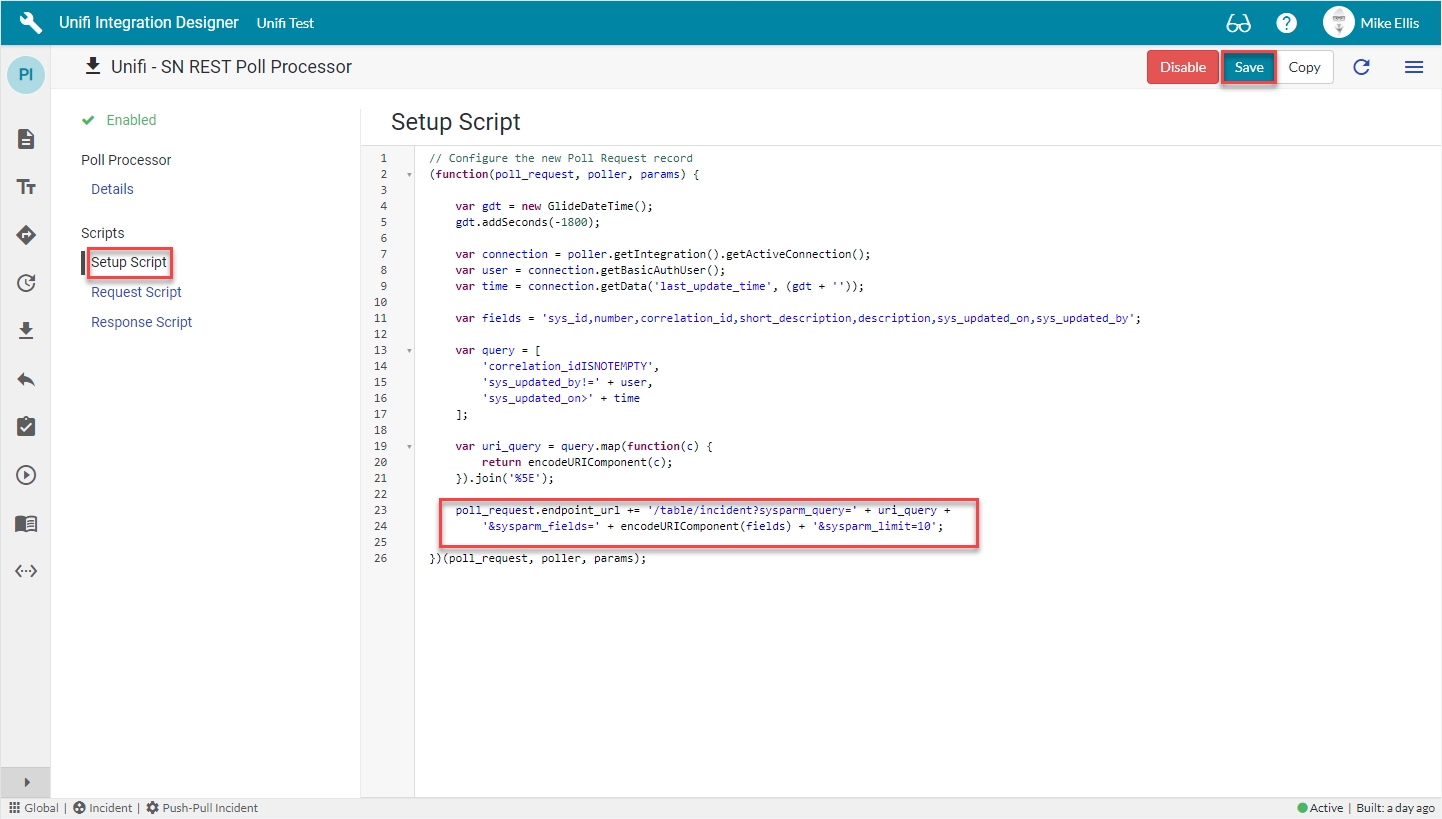

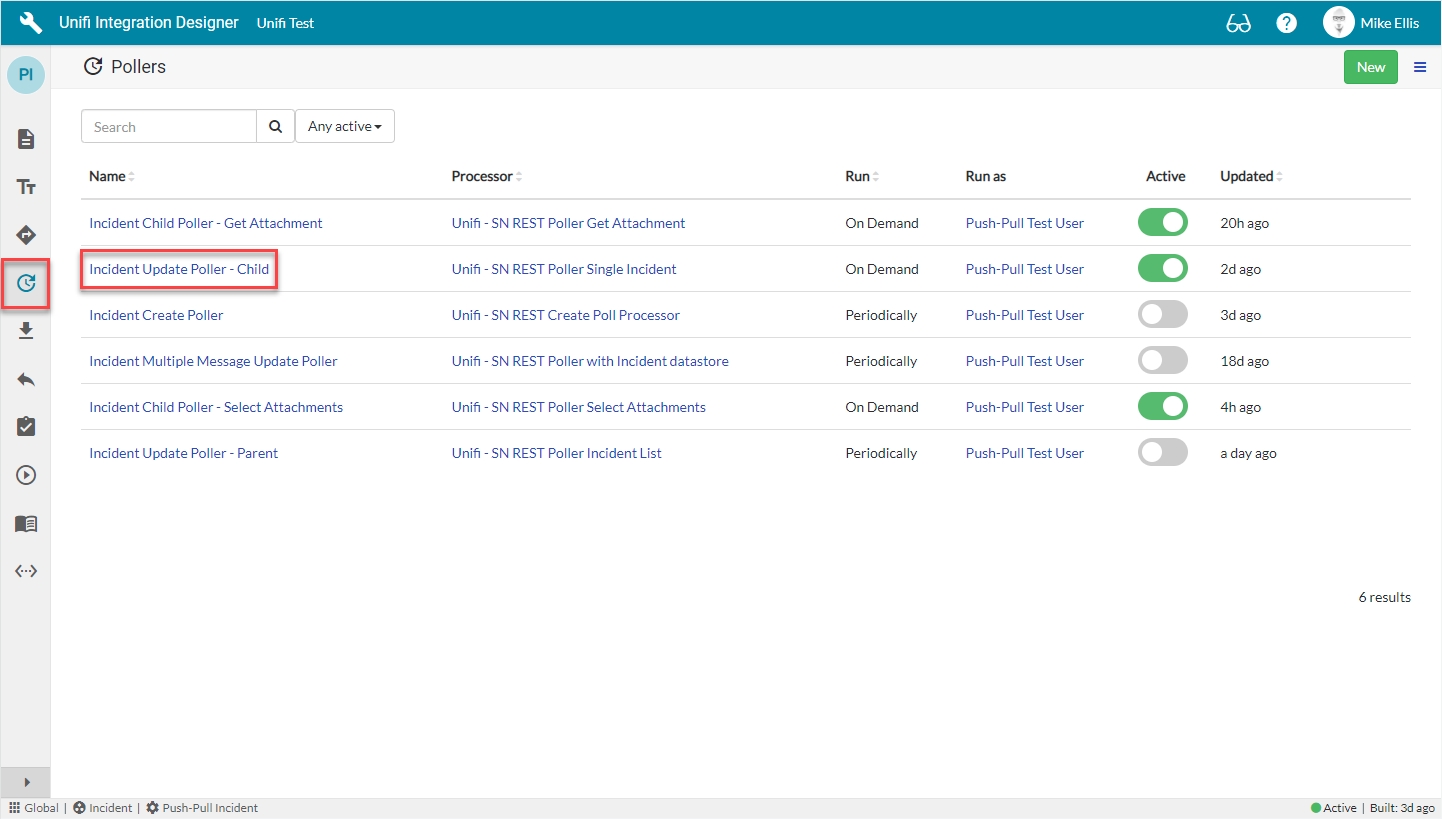
The Poll Processor contains the logic that will be applied when polling a remote system for data.
The Poll Processor is a configuration record which contains the logic that will be applied when polling a remote system for data. There are three main scripts which are used to setup, execute and process the Poll Requests. The scripts given here are examples of how you might configure your Poll. The details of yours may differ depending on your requirements.
This Get Attachment Poll Processor will take take each record passed to it from its parent - Select Attachments Poll Processor - and then make a Poll Request against that record, retrieving the attachment, building a payload and passing it to Unifi to process.


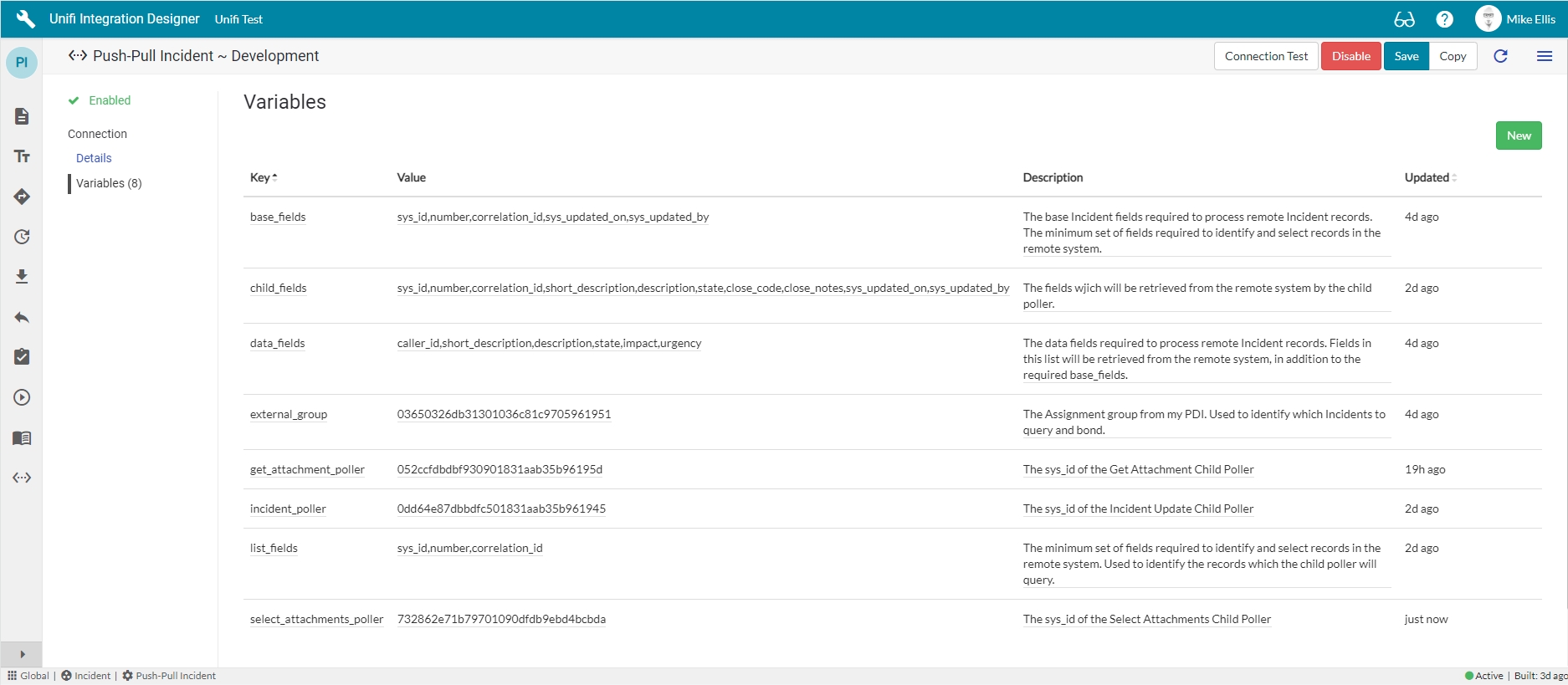

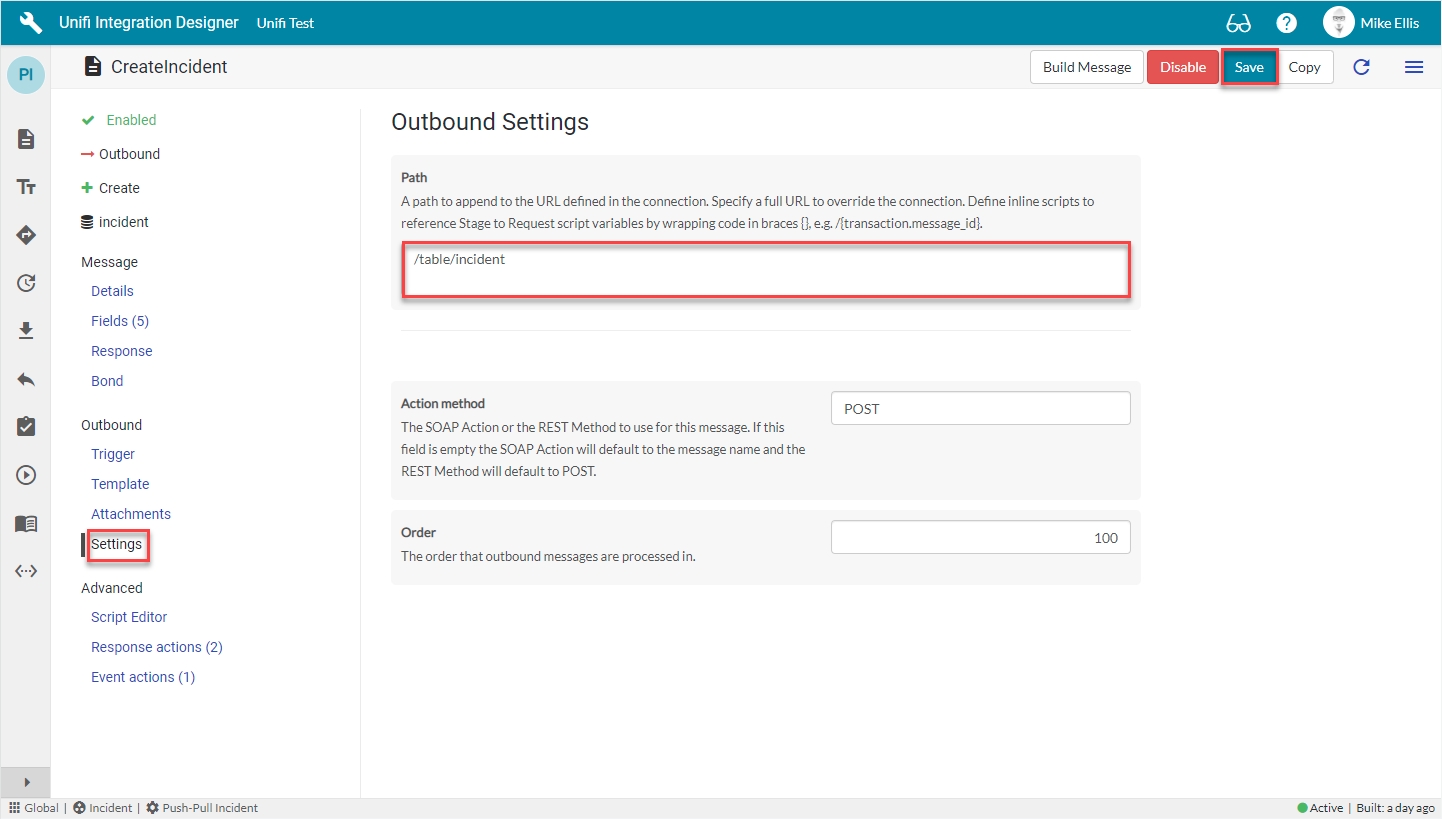
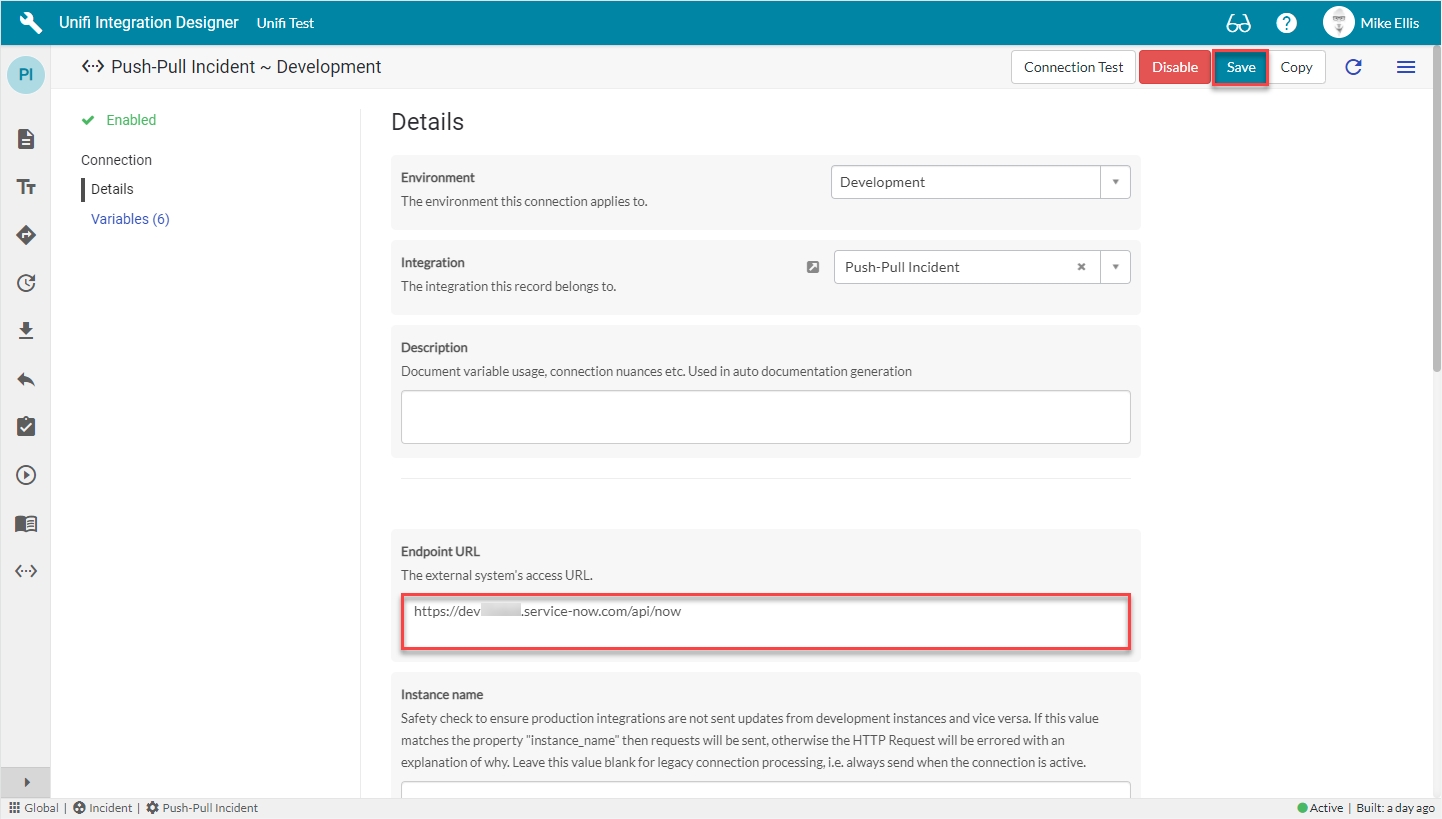
processInbound() method. It then runs the execute_child_poller() function and saves the current incident as the previous incident for the next poll & checks whether the ticket was updated later than the last update time; if so, it sets and stores the last update time as that ‘sys_updated_on’ value (this ‘last_update_time’ is what the Setup script checks against when defining what the Poll will do).On processing each result, it is then logged to the Response status field of the Poll Request.
params: The params object is passed through to the subsequent scripts (and on to further Pollers, if required). This is used to pass the int_ref, ext_ref & attachment_hwm elements to the child Poller.
Code Edits - The following code snippets were added to the existing codebase to facilitate polling for attachments:
This is a DataStore name constant to store a time based high water mark.
The x_snd_eb.Poller.execute() method has two parameters. In the first we pass the sys_id of the child Poller (as created on the 'Select Attachments Poller' page). In the second we pass an object containing the correlation_id on the bonded Incident as the int_ref element, the sys_id of the bonded Incident as the ext_ref element and the value of the ATTACHMENT_HWM DataStore as the attachment_hwm element (telling the child Poller which attachment records to poll).
Causing the execute_child_poller() function to run (as set up above) - passing in the Incident & Bond.
Name
The name of the Processor.
<Your Name>*
Response Script
The script that processes the response to the request.
Update the code in the Response script field so that it looks like the code below
In Unifi Integration Designer, navigate to & open < Your Integration > (created following the Outbound Incident Guide).
Click the 'Poll Processors' icon & then New.
The fields to be configured for the New Poll Processor modal are as follows:
Name
The name of the Processor.
<Your Name>
Run parallel
Allow concurrent Poll Requests to be executed.
<true>*
Your New Poll Processor modal should look like this:
Submit and view to further configure the Poll Processor.
The Setup Script is the first script to run (it runs at the point in time the Poll Request is created). It is used to build the environment for the poll and define what it will do. We will use it to setup the URL that will be called.
Navigate to Scripts > Setup Script.
The initial Poll Processor fields to be configured are as follows:
Setup script
The script to setup the Poll Request record.
Update the code in the Setup script field so that it looks like the code below
The code in the Setup script field should look like this:
Your Setup Script form should look like this:
Navigate to Request Script.
The Request Script is used to reach into the remote system and execute the request. We will use the ServiceNow RESTMessageV2() web service to make a REST call to the URL defined in the Setup Script.
The next Poll Processor field to be configured is as follows:
Request script
The script that executes the request.
Update the code in the Request script field so that it looks like the code below
The code in the Request script field should look like this:
Your Request Script form should look like this:
Navigate to Response Script.
The Response Script is used to process the information returned from the remote system. We will pass this data to Unifi, telling it which Message to use to process the data.
The last Poll Processor field to be configured is as follows:
Response script
The script that processes the response to the request.
Update the code in the Response script field so that it looks like the code below
The code in the Response script field should look like this:
Your Response Script form should look like this:
Save the Poll Processor.
Now let's move on and configure the Get Attachment Poller.
The Poll Processor contains the logic that will be applied when polling a remote system for data.
The Poll Processor is a configuration record which contains the logic that will be applied when polling a remote system for data. There are three main scripts which are used to setup, execute and process the Poll Requests. The scripts given here are examples of how you might configure your Poll. The details of yours may differ depending on your requirements.
This Select Attachments Poll Processor will pull back a list of the relevant attachment records. Each record it identifies will be passed on to its child - Get Attachment Poll Processor.
In Unifi Integration Designer, navigate to & open < Your Integration > (created following the Outbound Incident Guide).
Click the 'Poll Processors' icon & then New.
The fields to be configured for the New Poll Processor modal are as follows:
Your New Poll Processor modal should look like this:
Submit and view to further configure the Poll Processor.
The Setup Script is the first script to run (it runs at the point in time the Poll Request is created). It is used to build the environment for the poll and define what it will do. We will use it to setup the URL that will be called.
Navigate to Scripts > Setup Script.
The initial Poll Processor fields to be configured are as follows:
The code in the Setup script field should look like this:
Your Setup Script form should look like this:
Navigate to Request Script.
The Request Script is used to reach into the remote system and execute the request. We will use the ServiceNow RESTMessageV2() web service to make a REST call to the URL defined in the Setup Script.
The next Poll Processor field to be configured is as follows:
The code in the Request script field should look like this:
Your Request Script form should look like this:
Navigate to Response Script.
The Response Script is used to process the information returned from the remote system. We will use it to build an attachment object to pass this data to the next Poll Processor.
The last Poll Processor field to be configured is as follows:
The code in the Response script field should look like this:
Your Response Script form should look like this:
Save the Poll Processor.
Navigate to and open the Get Attachment Poll Processor (created on the '' page) and update the value of the Parent field by selecting its parent Poll Processor created above.
Now let's move on and configure the Select Attachments Poller.
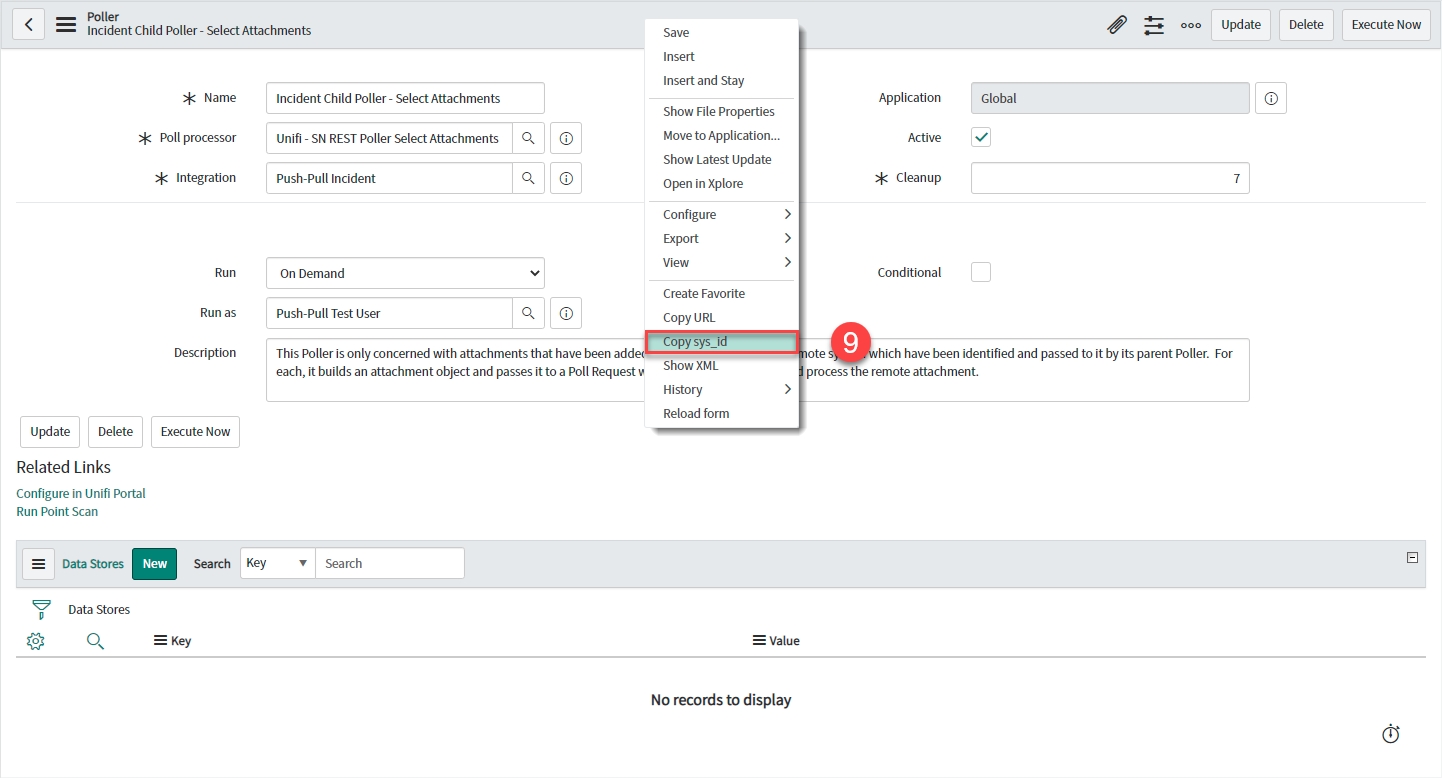
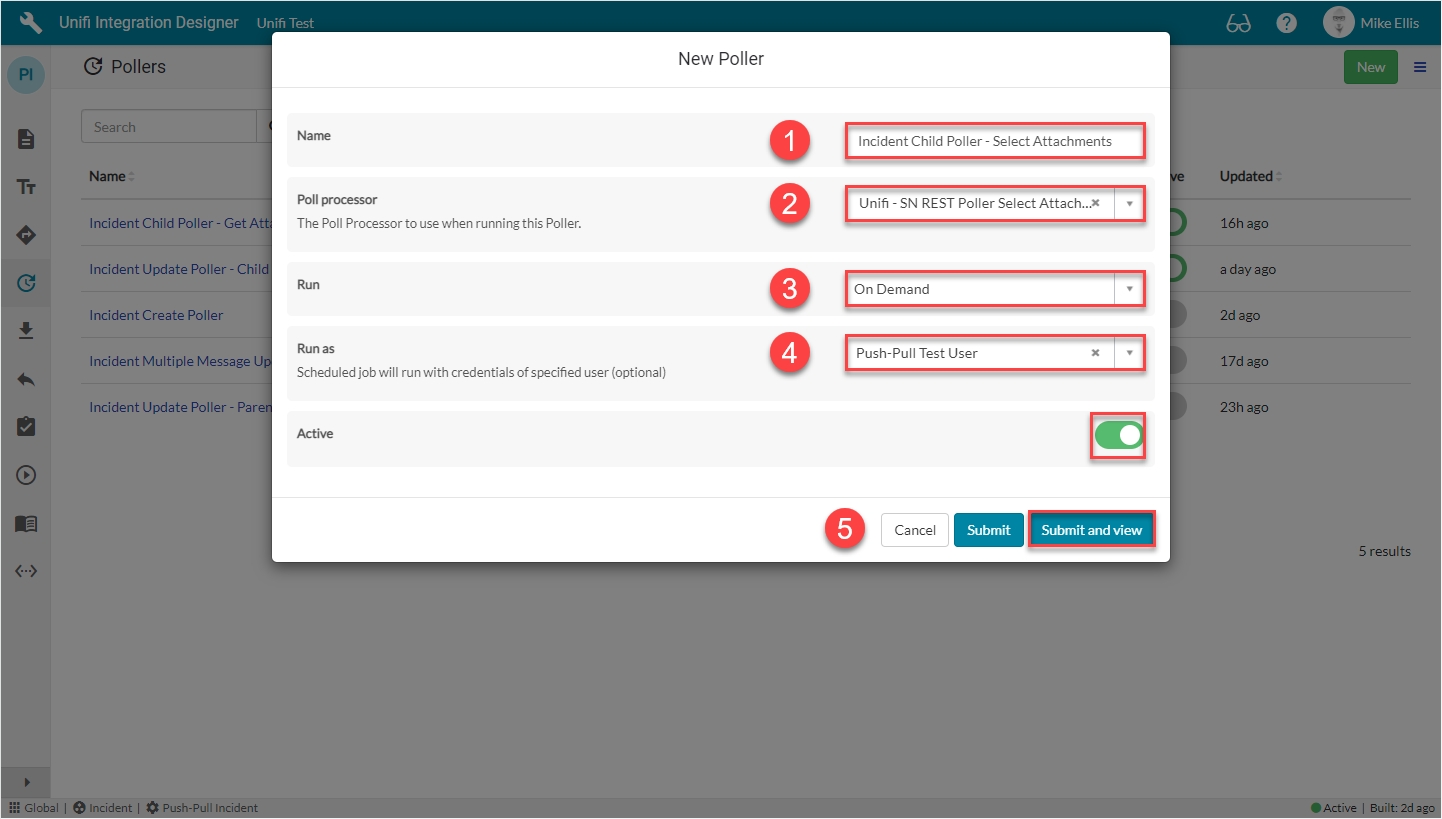
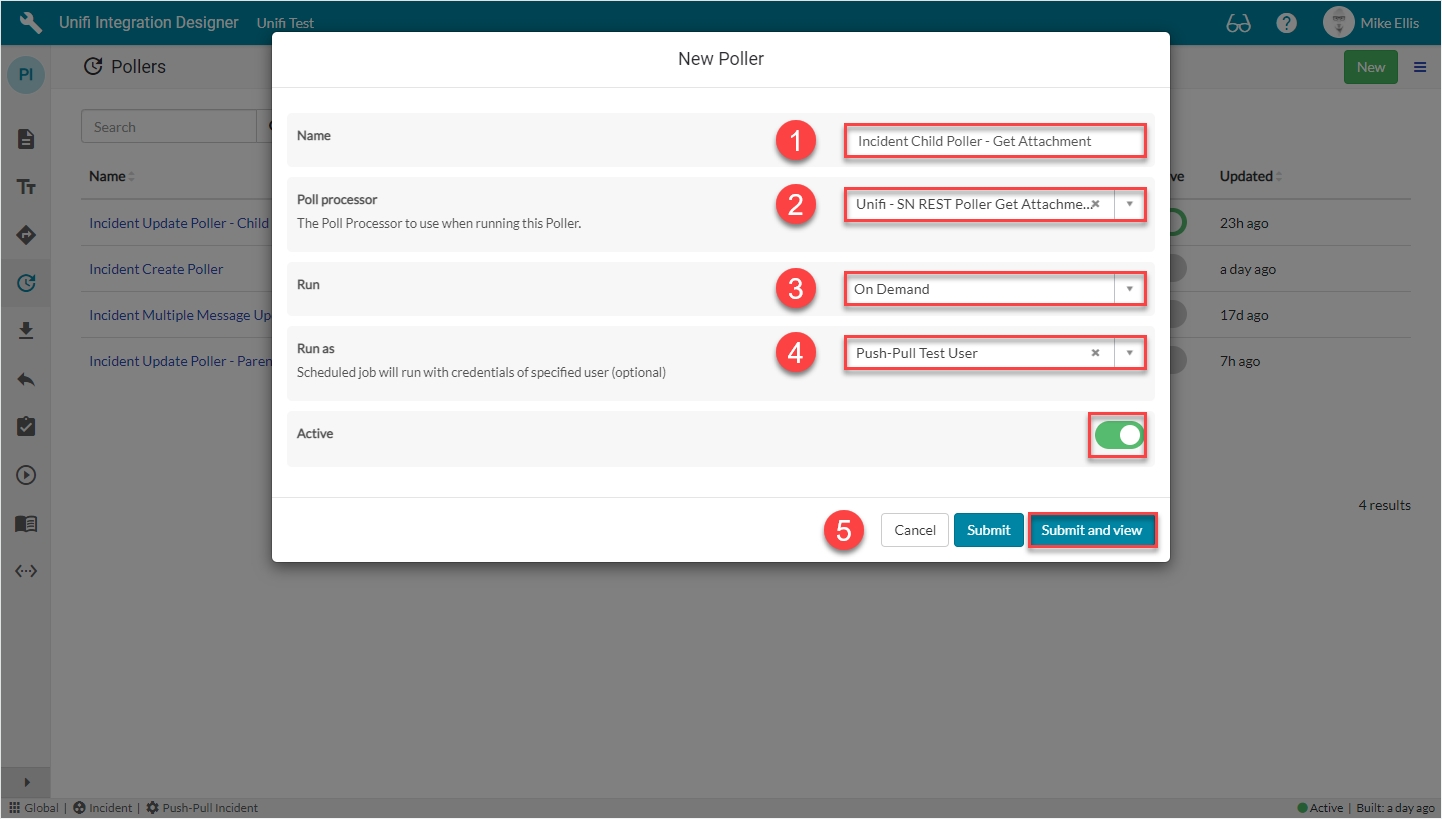
// Process the response returned by the request script
// The 'answer' variable from the request script is passed in here as the 'response' parameter
(function(poll_request, poller, response, params) {
// DataStore name constant
// Storage of time based High Water Marker
var ATTACHMENT_HWM = 'attachment_hwm';
var body = JSON.parse(response);
// Nothing to do if no results were returned
if (body.result.length == 0) {
poll_request.response_status = 'No Incidents returned\n\n' + JSON.stringify(body, null, 2);
return;
}
// Sample result (single Incident)
/*
{
"result": {
"sys_id": "0ecc4865db734010c3ebde82ca961960",
"number": "INC0010107",
"correlation_id": "INC0010345",
"short_description": "Demo two - Fixing request",
"description": "A long description",
"state":"2",
"sys_updated_on": "2020-04-02 14:00:00",
"sys_updated_by": "a.user"
}
}
*/
// Establish the environment
var integration = poller.getIntegration();
var config = integration.getConfig();
var conn = integration.getActiveConnection();
var cvars = conn.getVariables();
var poll_helper = new x_snd_eb.PollHelper(poll_request);
var info = [];
// Use Unifi code to find the Bond for an Incident
function get_bond(inc) {
var bond = new x_snd_eb.Bond(config);
bond.locateReference(integration, inc.correlation_id, inc.sys_id);
if (!bond.isValidRecord()) {
return null;
}
return bond;
}
// Work out the message type to send to Unifi based upon the change of state
function get_message_name(curr, prev) {
// Default message type is an update
var message_name = 'UpdateIncidentInbound';
// Use the default type if we have no previous state
if (!prev || !prev.state) {
return message_name;
}
// Use the default type if there is no change in state
if (curr.state == prev.state) {
return message_name;
}
// We know the state has changed, check if it is Resolved (6)
if (curr.state == '6') {
message_name = 'ResolveIncidentInbound';
}
return message_name;
}
function execute_child_poller(inc, bond) {
if (!bond) {
return {};
}
// Set up a Poll to check for new attachments
x_snd_eb.Poller.execute(cvars.select_attachments_poller, {
int_ref: inc.correlation_id,
ext_ref: inc.sys_id,
attachment_hwm: bond.getData(ATTACHMENT_HWM, '')
});
}
function process_incident(inc) {
// Log the incident number and time
var inc_time = inc.sys_updated_on;
info.push('Incident : ' + inc.number + ' (' + inc_time + ')');
// Find the bond on which the previous data is stored
var bond = get_bond(inc);
// If no bond was found, ignore this incident
if (!bond) {
info.push('- Bond not found - Incident ignored');
return;
}
// Get the data stored for the incident by a previous poll
var previous_inc = bond.getDataObject('previous_inc', {
state: '2'
});
// Work out the message type to send into Unifi
var message_name = get_message_name(inc, previous_inc);
info.push('- Message name: ' + message_name);
// Set up the payload object for passing into Unifi
var payload = {
message: {
name: message_name,
source_reference: inc.sys_id
},
detail: {
short_description: inc.short_description,
description: inc.description,
state: inc.state,
close_code: inc.close_code,
close_notes: inc.close_notes
}
};
// Submit the message into Unifi
poll_helper.processInbound({
payload: JSON.stringify(payload)
});
// Check for Attachments
execute_child_poller(inc, bond);
// Save the current incident as the previous incident for the next poll
bond.setDataObject('previous_inc', inc);
// Update last update time (if later)
var conn_time = conn.getData('last_update_time', '');
if (inc_time > conn_time) {
conn.setData('last_update_time', inc_time);
}
}
// Process the single result
process_incident(body.result);
poll_request.response_status = info.join('\n') + '\n\n' + JSON.stringify(body, null, 2);
})(poll_request, poller, response, params); var ATTACHMENT_HWM = 'attachment_hwm'; function execute_child_poller(inc, bond) {
if (!bond) {
return {};
}
// Set up a Poll to check for new attachments
x_snd_eb.Poller.execute(cvars.select_attachments_poller, {
int_ref: inc.correlation_id,
ext_ref: inc.sys_id,
attachment_hwm: bond.getData(ATTACHMENT_HWM, '')
});
} execute_child_poller(inc, bond);var poll_helper = new x_snd_eb.PollHelper(poll_request);poll_helper.processInbound({
message_name : 'AddAttachmentInbound',
payload : JSON.stringify(payload)
});// Configure the new Poll Request record
(function (poll_request, poller, params) {
// Params contain an attachment object containing details of the remote attachment
// remote_id : The sys_id of the attachment in the remote system
// Also contains: file_name, content_type, size_bytes
var attach_id = params.attachment.remote_id;
poll_request.endpoint_url += '/attachment/' + attach_id + '/file';
})(poll_request, poller, params);// Process the request e.g. by executing a web service and returning the response
(function (poll_request, poller, connection, params) {
var request, response;
request = new sn_ws.RESTMessageV2();
request.setHttpMethod('GET');
request.setEndpoint(poll_request.endpoint_url);
request.setRequestHeader('Content-Type','application/json');
request.setBasicAuth(connection.getBasicAuthUser(), connection.getBasicAuthPassword());
// Save the response as a new attachment (on the poll request)
request.saveResponseBodyAsAttachment(
poll_request.getTableName(), poll_request.sys_id, params.attachment.file_name
);
response = request.execute();
poll_request.response_code = response.getStatusCode();
poll_request.response_status = response.getErrorMessage();
if (response.haveError()) {
throw '\nResponse Code: ' + response.getErrorCode() + '\nResponse error: ' + response.getErrorMessage();
}
// Return the sys_id of the saved attachment
answer = response.getResponseAttachmentSysid() + '';
})(poll_request, poller, connection, params);// Process the response returned by the request script
// The 'answer' variable from the request script is passed in here as the 'response' parameter
(function (poll_request, poller, response, params) {
// Establish the environment
var poll_helper = new x_snd_eb.PollHelper(poll_request);
var info = [
'Incident : ' + params.int_ref,
'- Attachment file name: ' + params.attachment.file_name,
'- Attachment id: ' + response
];
// The response should be the sys_id of the created attachment
params.attachment.data = '<x-attachment-data sys_id="' + response + '" />';
// Build the payload for Unifi
var payload = {
sys_id : params.ext_ref,
correlation_id : params.int_ref,
attachment : params.attachment
};
// Submit the message into Unifi
poll_helper.processInbound({
message_name : 'AddAttachmentInbound',
payload : JSON.stringify(payload)
});
poll_request.response_status = info.join('\n');
})(poll_request, poller, response, params);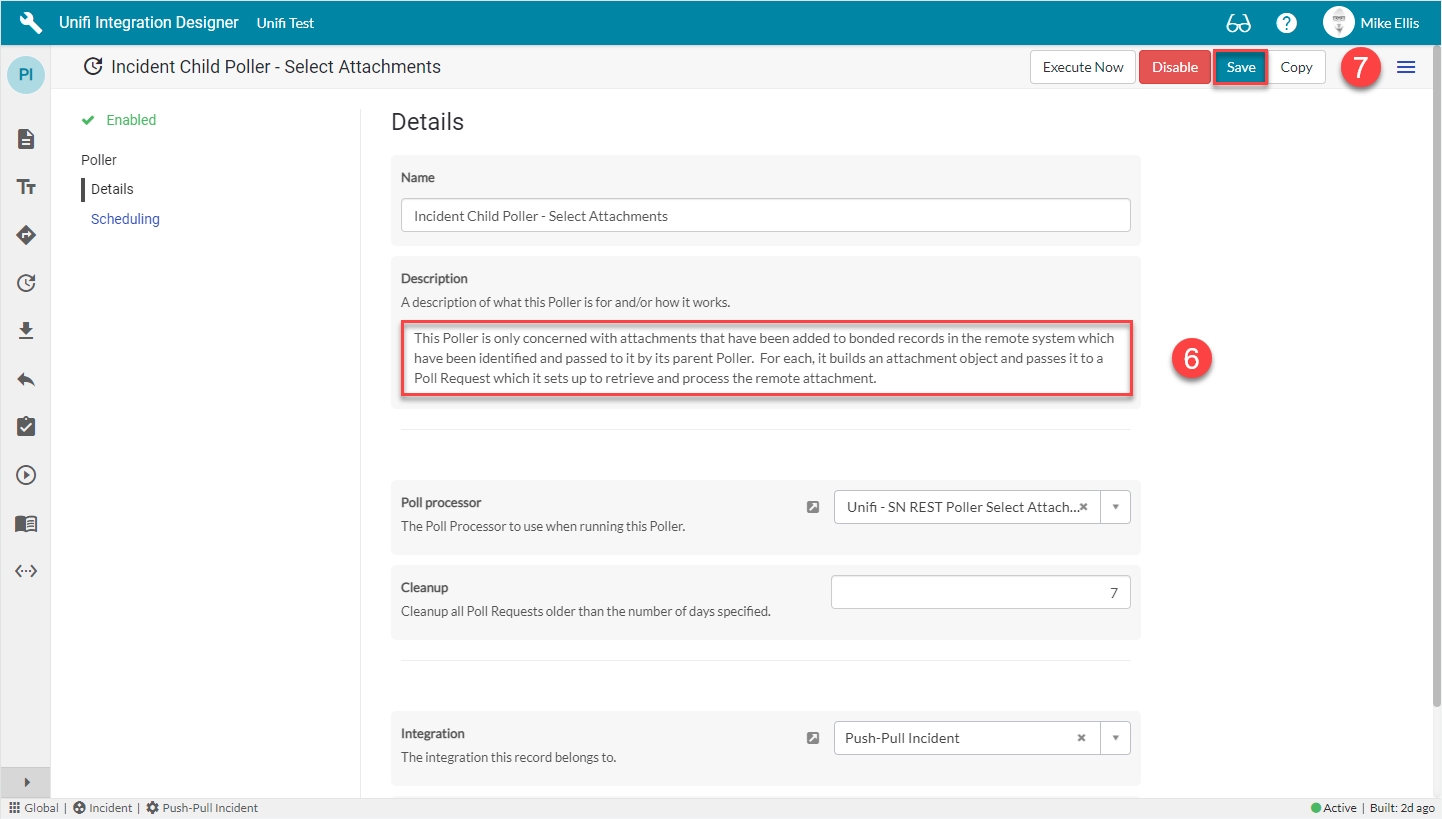
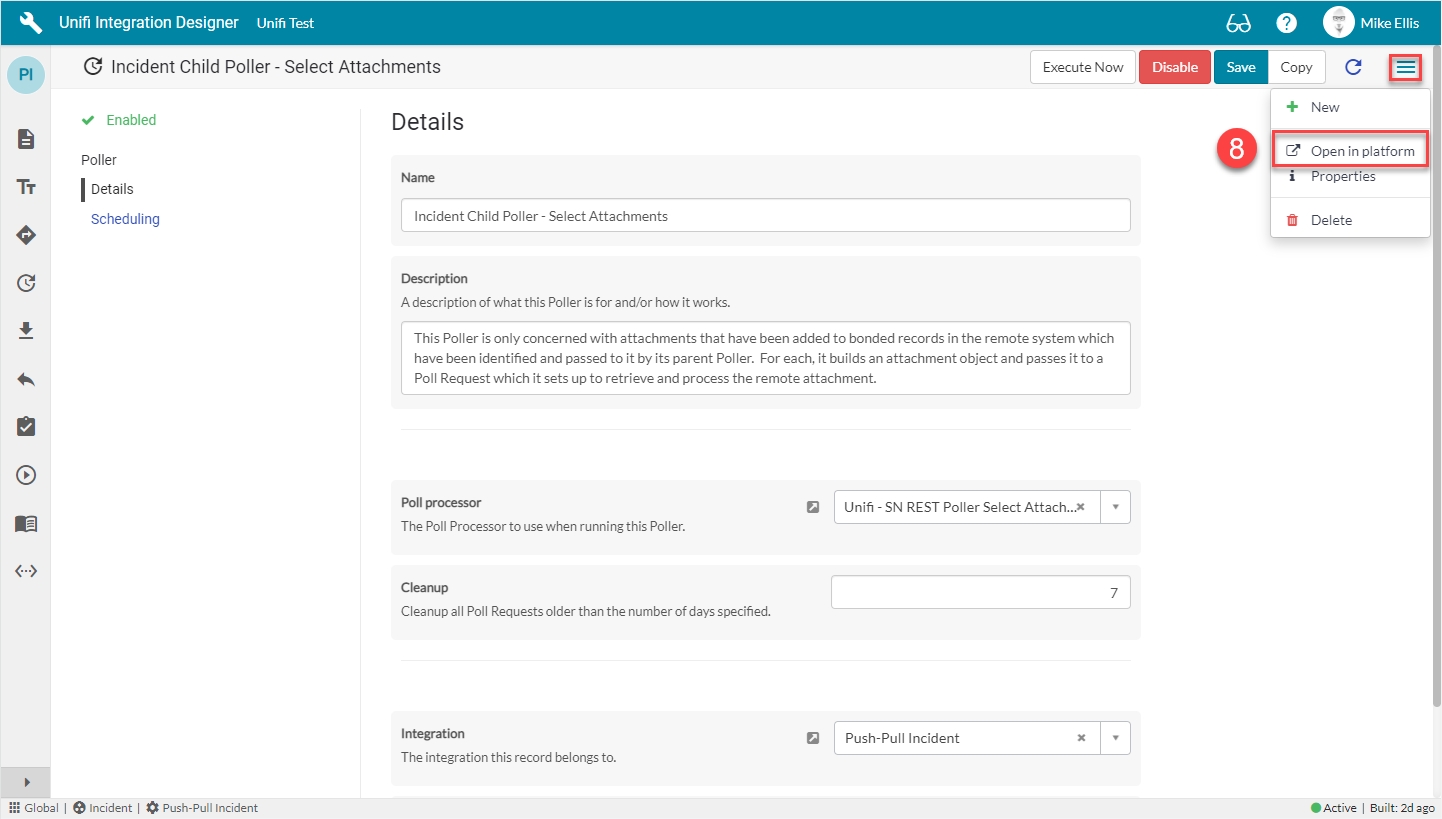
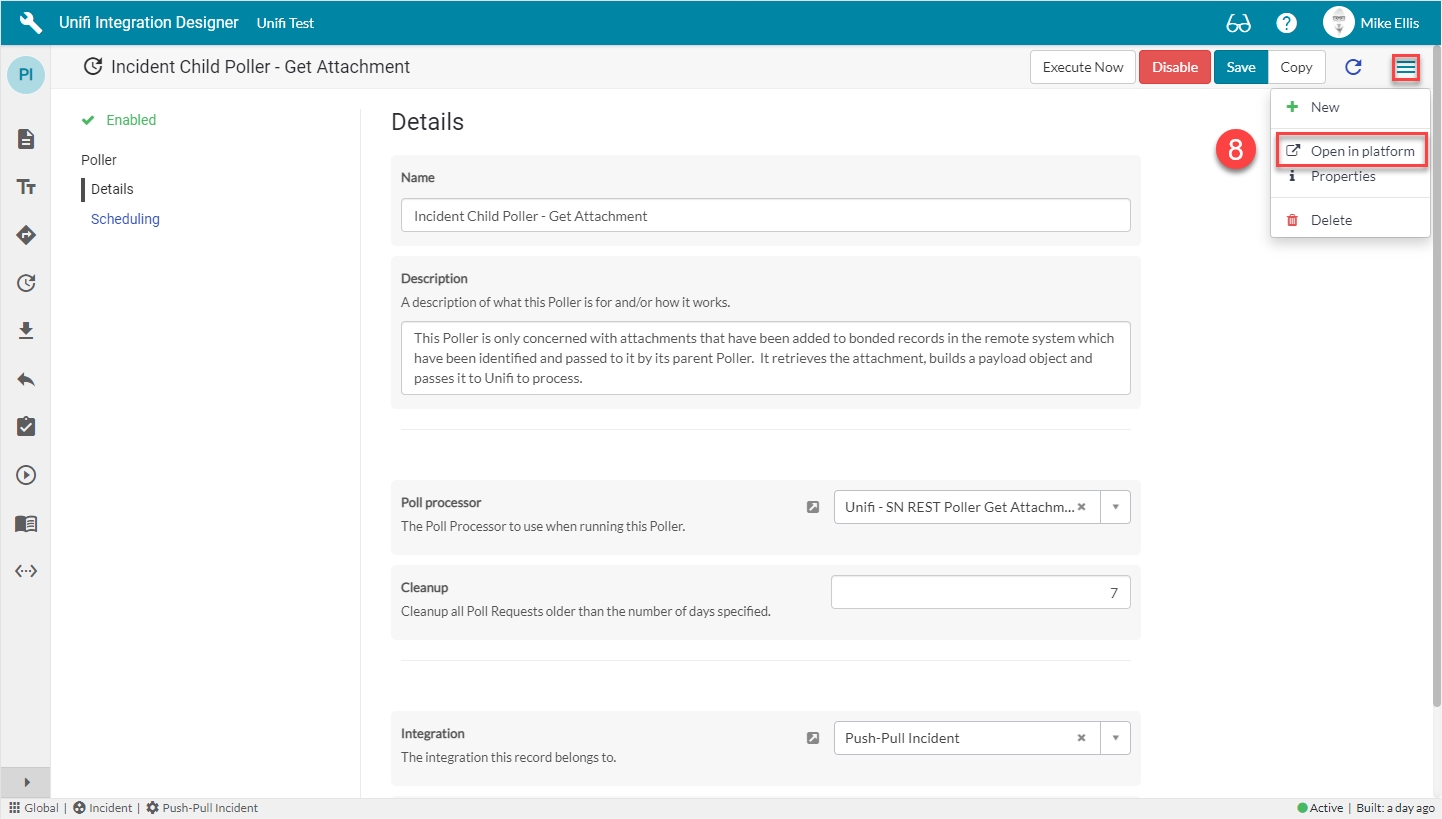
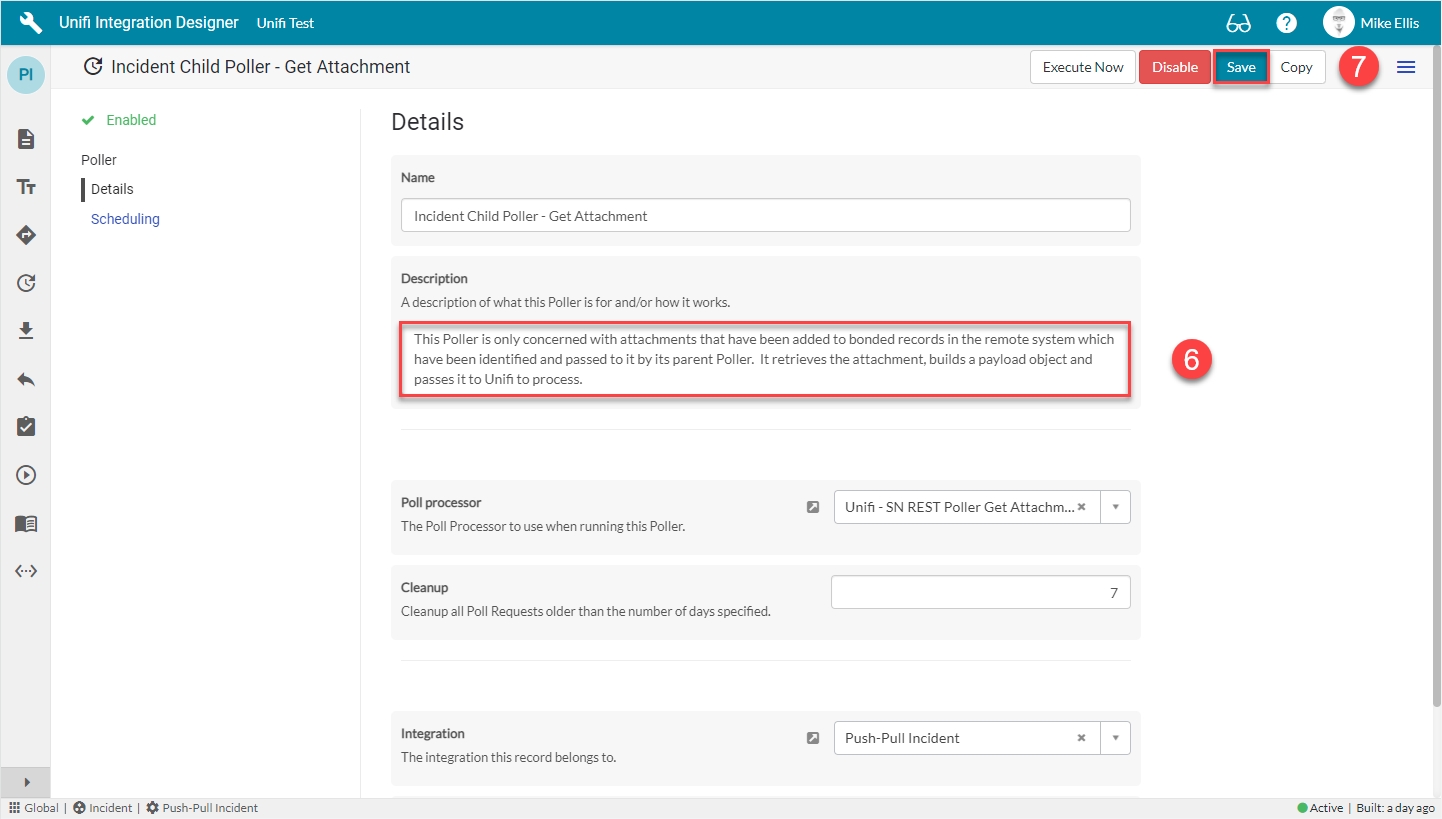
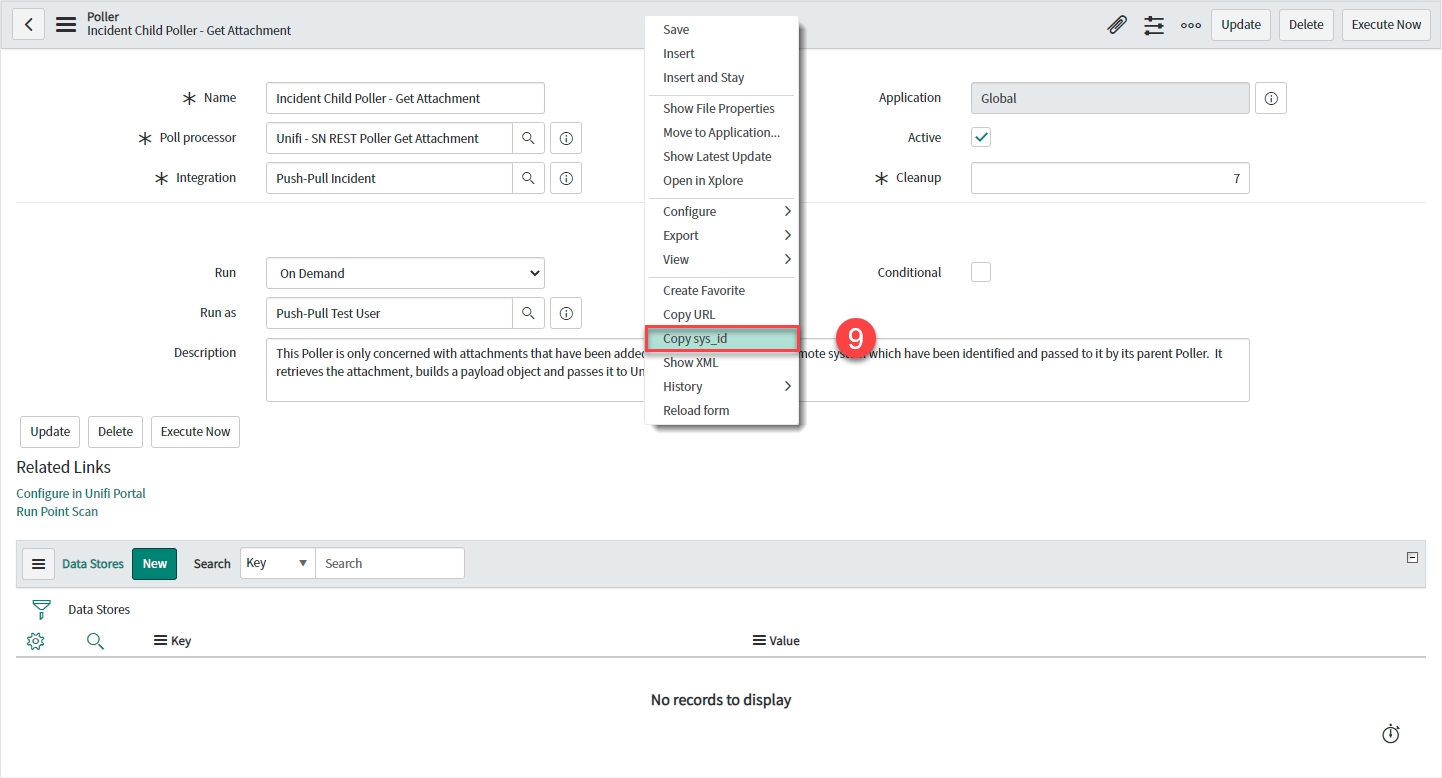
x_snd_eb.Poller.execute(): This method has two parameters. In the first we pass the sys_id of the child Poller (as created in __ the 'Get Attachment Poller' page). In the second we pass an object containing the correlation_id on the bonded Incident as the int_ref element, the sys_id of the bonded Incident as the ext_ref element and the attachment object as the attachment element (telling the child Poller which attachment record to poll).
params: The params object is passed through to the subsequent scripts (and on to further Pollers, if required). This is used to pass the int_ref, ext_ref & attachment elements to the child Poller.
Name
The name of the Processor.
<Your name>
Setup script
The script to setup the Poll Request record.
Update the code in the Setup script field so that it looks like the code below
Request script
The script that executes the request.
Update the code in the Request script field so that it looks like the code below
Response script
The script that processes the response to the request.
Update the code in the Response script field so that it looks like the code below
// Configure the new Poll Request record
(function (poll_request, poller, params) {
var gdt = new GlideDateTime();
gdt.addSeconds(-1800);
var conn = poller.getIntegration().getActiveConnection();
var user = conn.getBasicAuthUser();
var time = params.attachment_hwm || (gdt+'');
var query = [
'table_sys_id=' + params.ext_ref,
'sys_created_by!=' + user,
'sys_created_on>' + time,
'ORDERBYsys_created_on'
];
var uri_query = query.map(function(c) { return encodeURIComponent(c); }).join('%5E');
poll_request.endpoint_url += '/attachment?sysparm_query=' + uri_query + '&sysparm_limit=10';
})(poll_request, poller, params);// Process the request e.g. by executing a web service and returning the response
(function(poll_request, poller, connection, params) {
var rm = new sn_ws.RESTMessageV2();
rm.setEndpoint(poll_request.endpoint_url);
rm.setHttpMethod('GET');
rm.setRequestHeader('Accept', 'application/json');
rm.setRequestHeader('Content-type', 'application/json');
rm.setBasicAuth(connection.getBasicAuthUser(), connection.getBasicAuthPassword());
// rm.setRequestBody(JSON.stringify(body));
var resp = rm.execute();
answer = resp.getBody() + '';
})(poll_request, poller, connection, params);// Process the response returned by the request script
// The 'answer' variable from the request script is passed in here as the 'response' parameter
(function (poll_request, poller, response, params) {
// DataStore name constants
// Storage of time based High Water Marker
var ATTACHMENT_HWM = 'attachment_hwm';
var body = JSON.parse(response);
// Nothing to do if no results were returned
if ( body.result.length == 0 ) {
poll_request.response_status = 'No Attachments returned\n\n' + JSON.stringify(body,null,2);
return;
}
/*
{
"size_bytes": "2330",
"file_name": "MPFD-!--1539262705666--!",
"sys_mod_count": "0",
"average_image_color": "",
"image_width": "",
"sys_updated_on": "2018-10-11 12:58:26",
"sys_tags": "",
"table_name": "incident",
"sys_id": "6c559892db812300f56c711ebf96192d",
"image_height": "",
"sys_updated_by": "ws_hn",
"download_link": "https://dev22291.service-now.com/api/now/attachment/6c559892db812300f56c711ebf96192d/file",
"content_type": "application/octet-stream",
"sys_created_on": "2018-10-11 12:58:26",
"size_compressed": "1055",
"compressed": "true",
"state": "",
"table_sys_id": "bcdf18d5db241300f56c711ebf961947",
"chunk_size_bytes": "",
"hash": "",
"sys_created_by": "ws_hn"
},
*/
// Establish the environment
var poll_helper = new x_snd_eb.PollHelper(poll_request);
var integration = poller.getIntegration();
var conn = integration.getActiveConnection();
var cvar = conn.getVariables();
var info = [
'Incident : ' + params.int_ref
];
// Use Unifi code to find the Bond for the Incident
var bond = new x_snd_eb.Bond(integration.getConfig());
bond.locateReference(integration,params.int_ref,params.ext_ref);
if ( !bond.isValidRecord() ) {
// If no bond was found, ignore this poll
info.push('- Bond not found - Attachments ignored');
poll_request.response_status = info.join('\n') + '\n\n' + JSON.stringify(body,null,2);
return;
}
var attachment_hwm;
// Process each result
body.result.forEach(function(attach){
// Build an attachment object to pass on to the next poller
var attachment = {
remote_id : attach.sys_id,
file_name : attach.file_name,
content_type : attach.content_type,
size_bytes : attach.size_bytes
};
info.push('- Get attachment (' + attach.remote_id + '): ' + attach.file_name);
x_snd_eb.Poller.execute( cvar.get_attachment_poller, {
int_ref : params.int_ref,
ext_ref : params.ext_ref,
attachment : attachment
});
// Keep track of the latest created_on time
attachment_hwm = attach.sys_created_on;
});
// Update Attachment High water mark (if later)
if ( attachment_hwm > params.attachment_hwm ) {
bond.setData(ATTACHMENT_HWM,attachment_hwm);
}
poll_request.response_status = info.join('\n') + '\n\n' + JSON.stringify(body,null,2);
})(poll_request, poller, response, params);